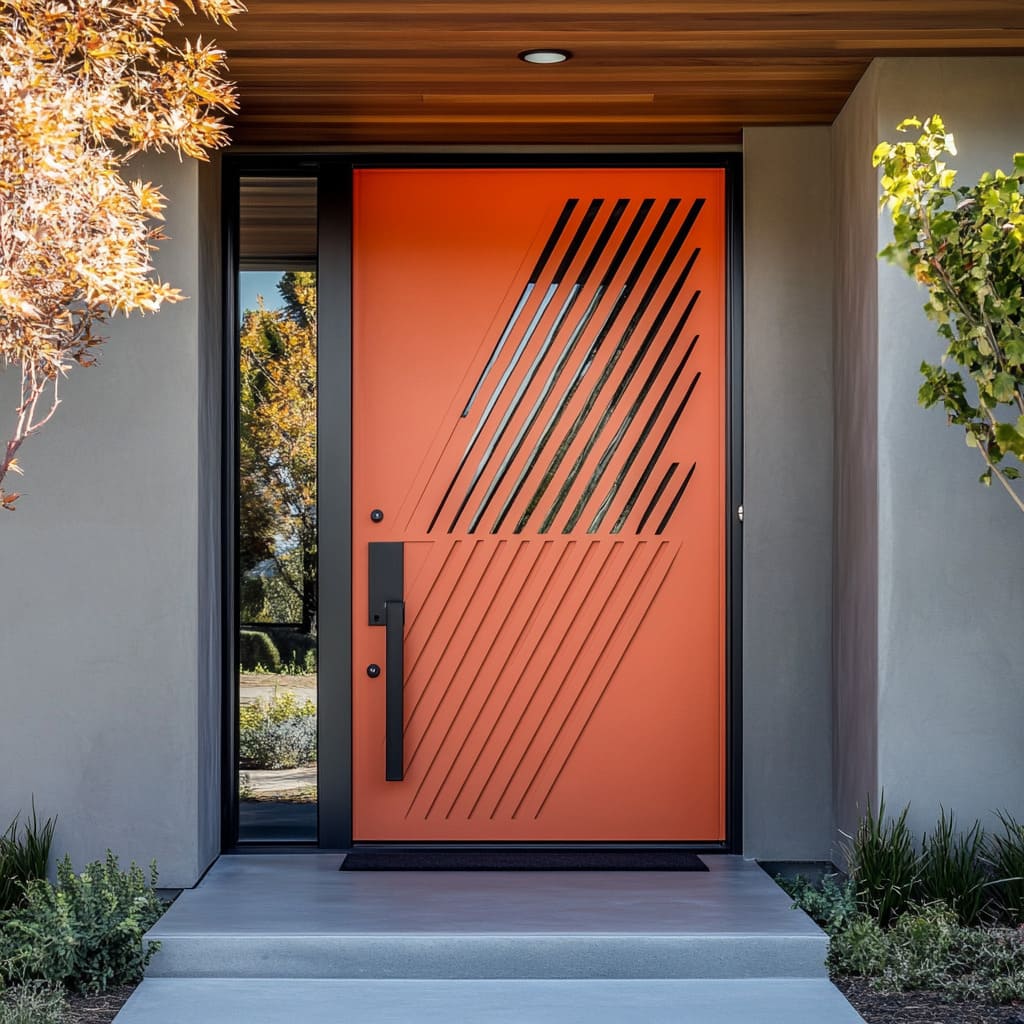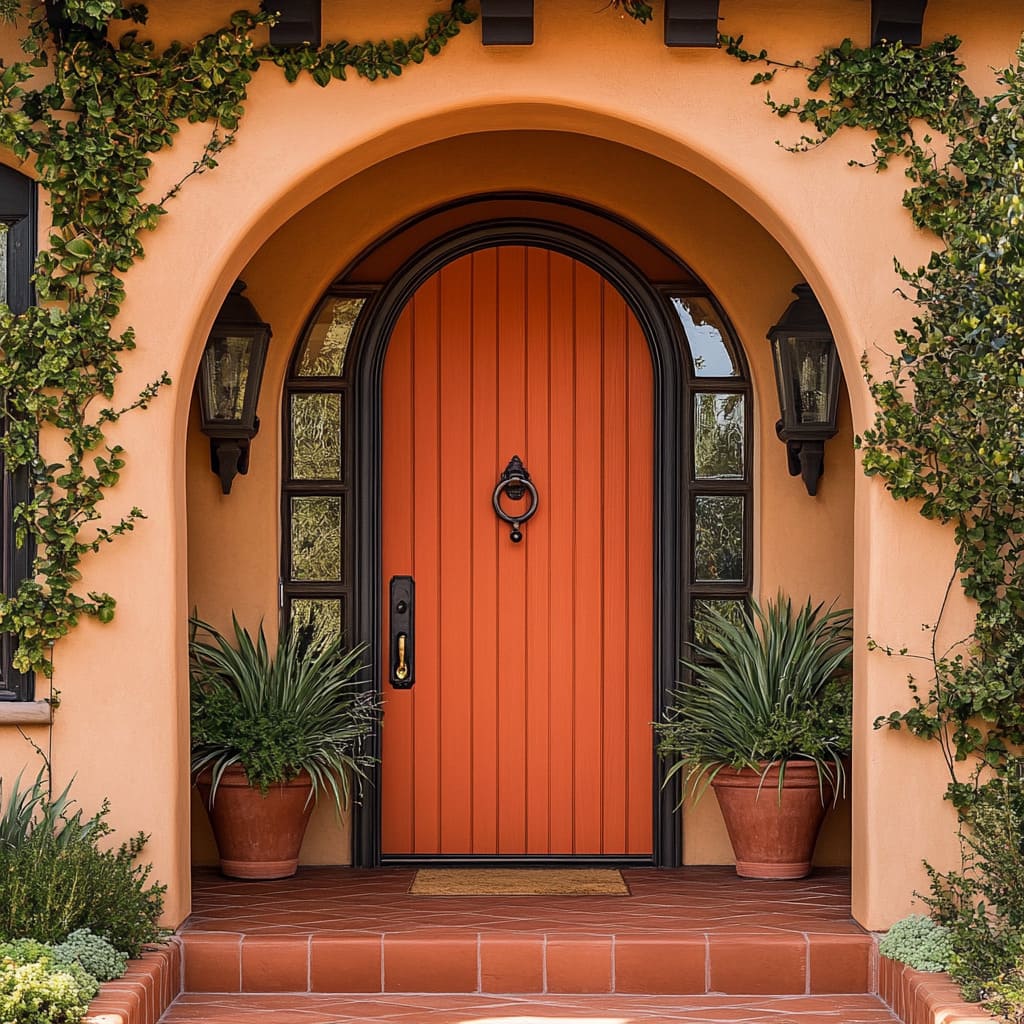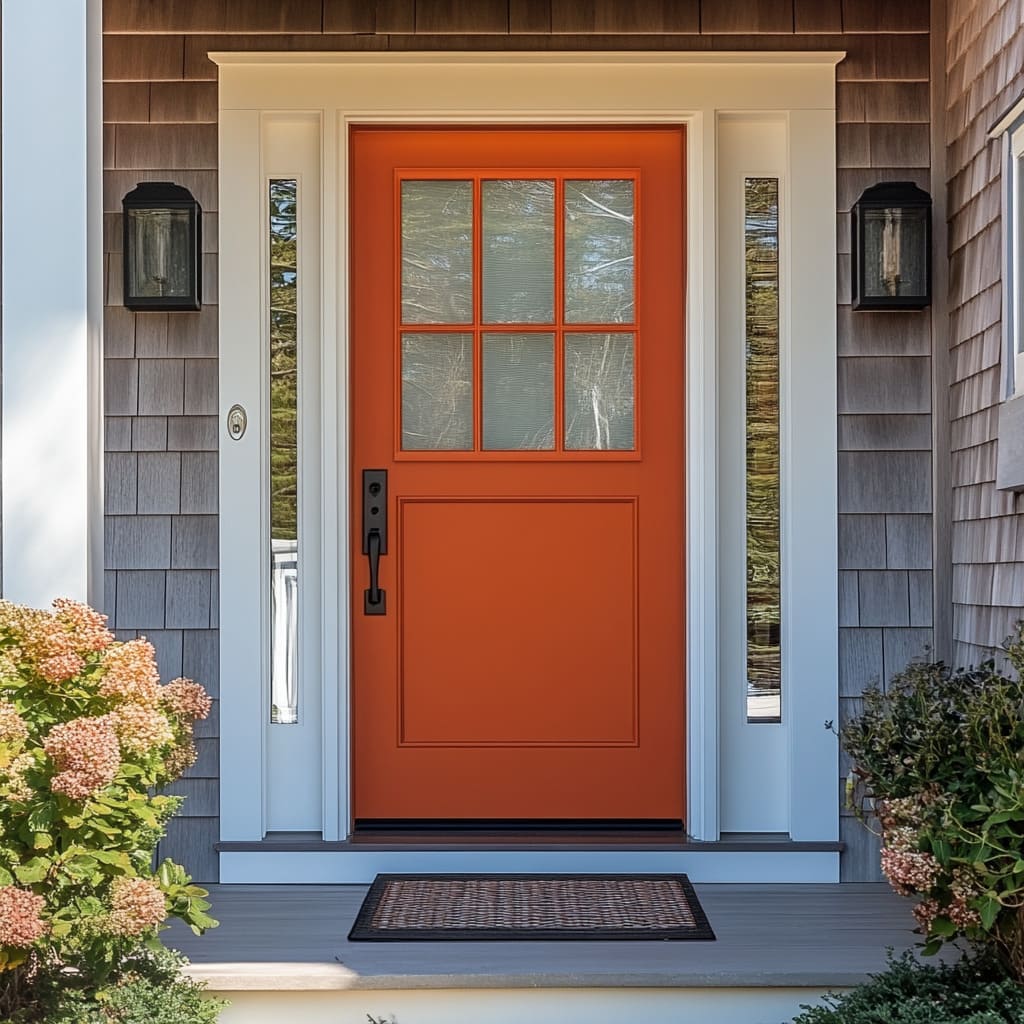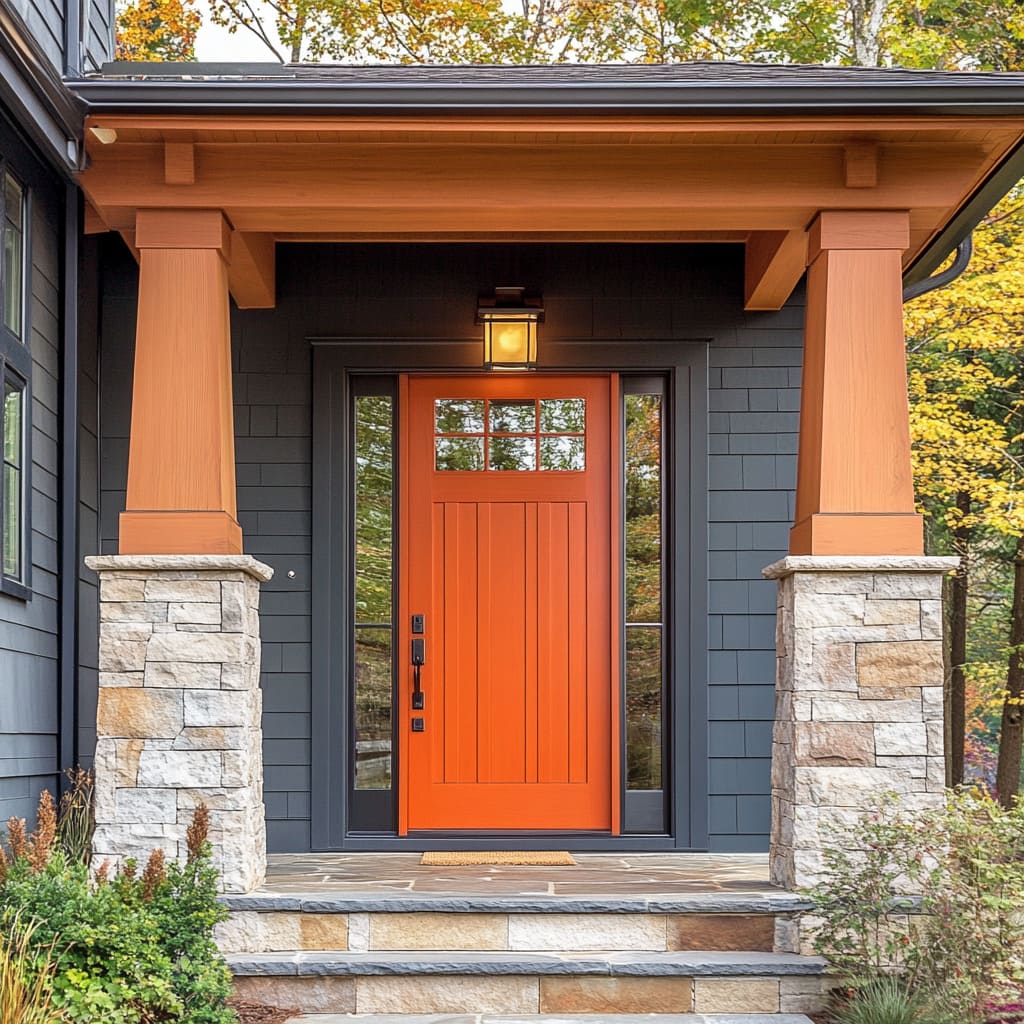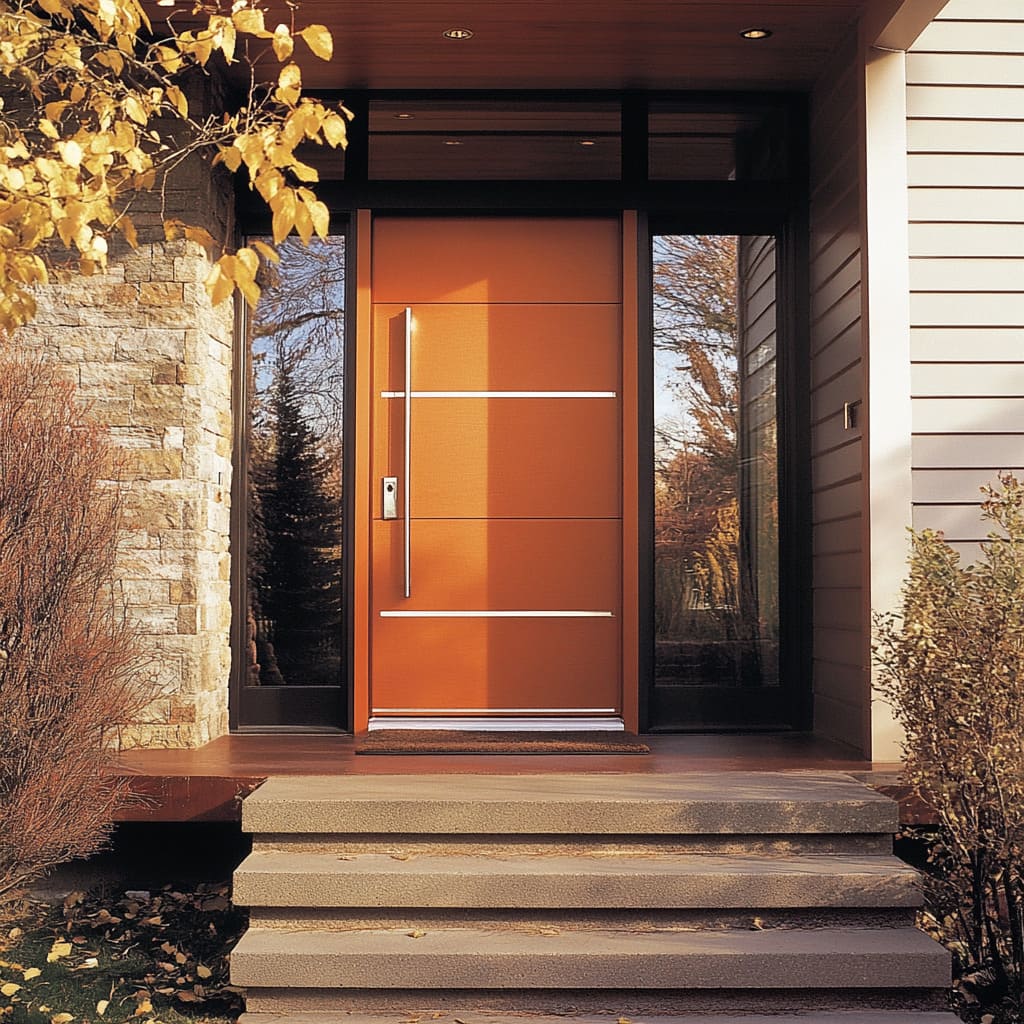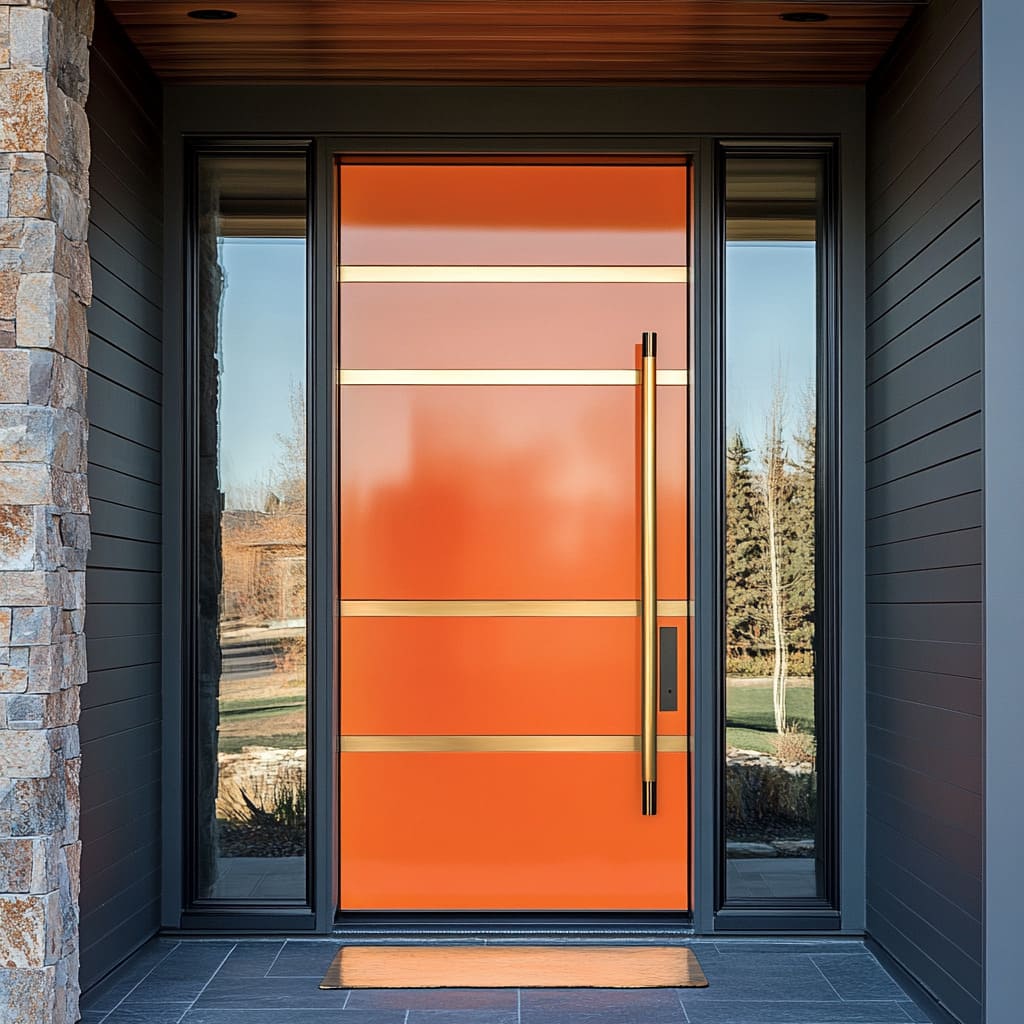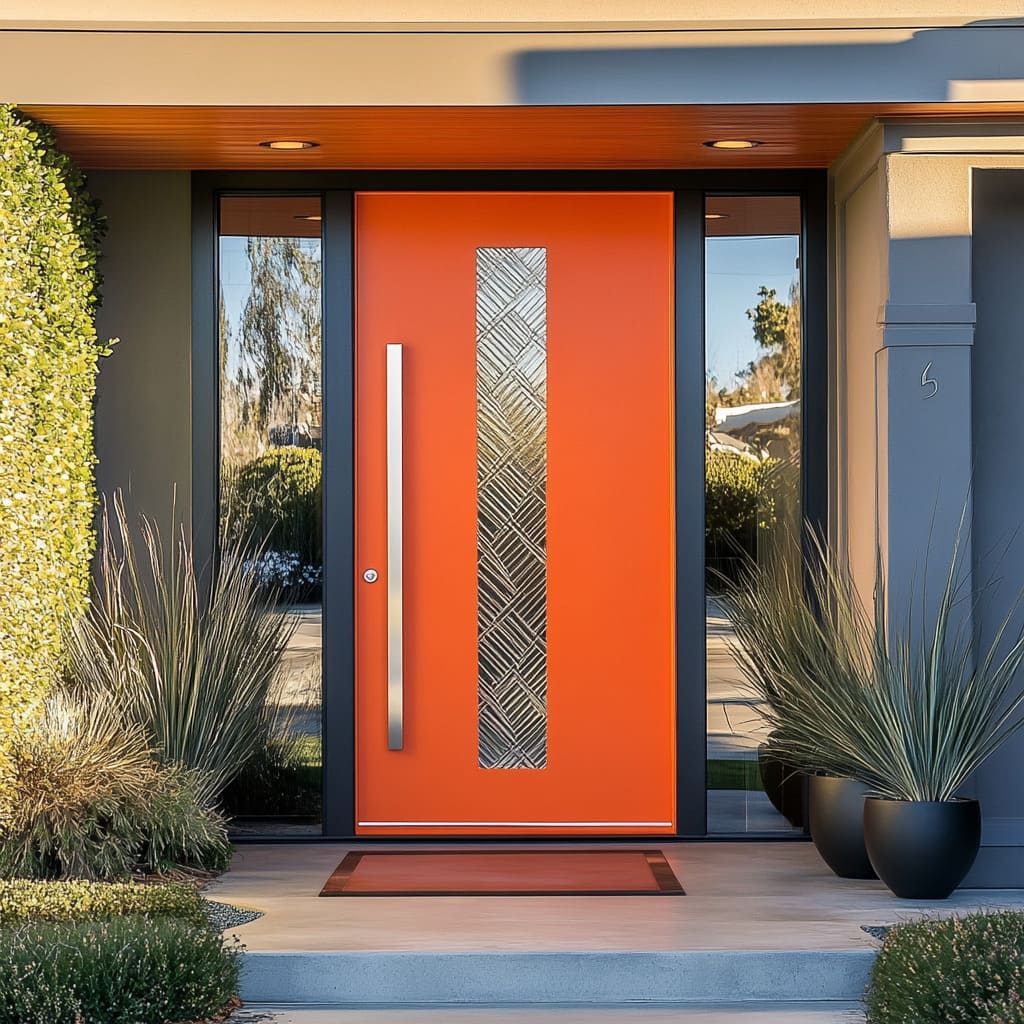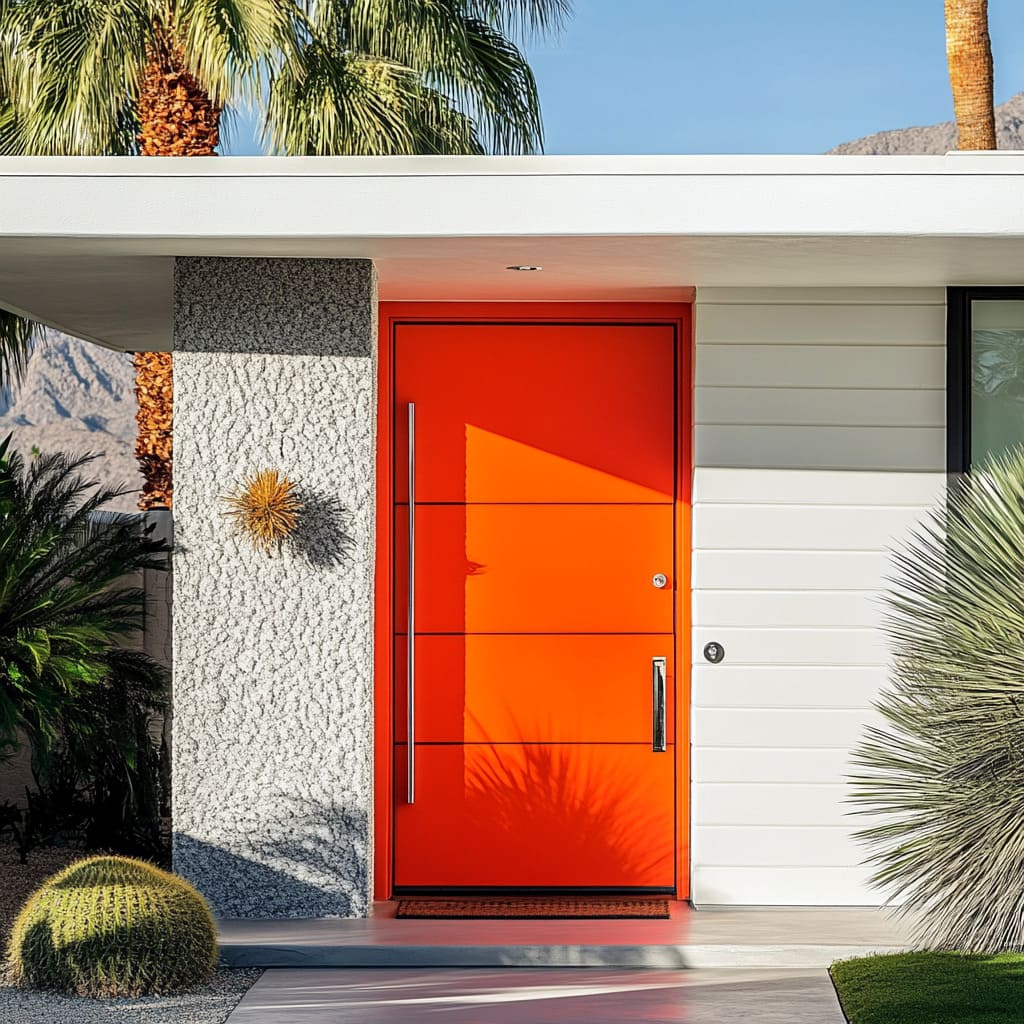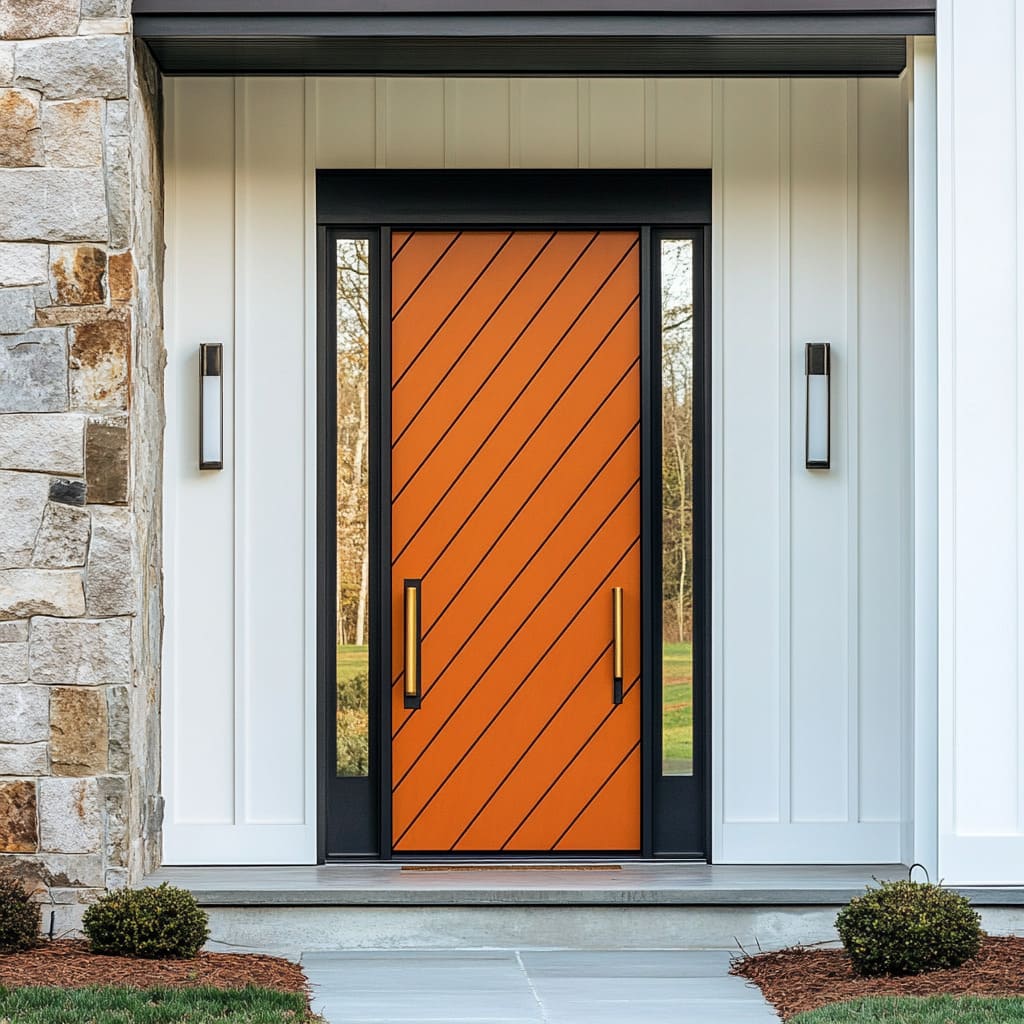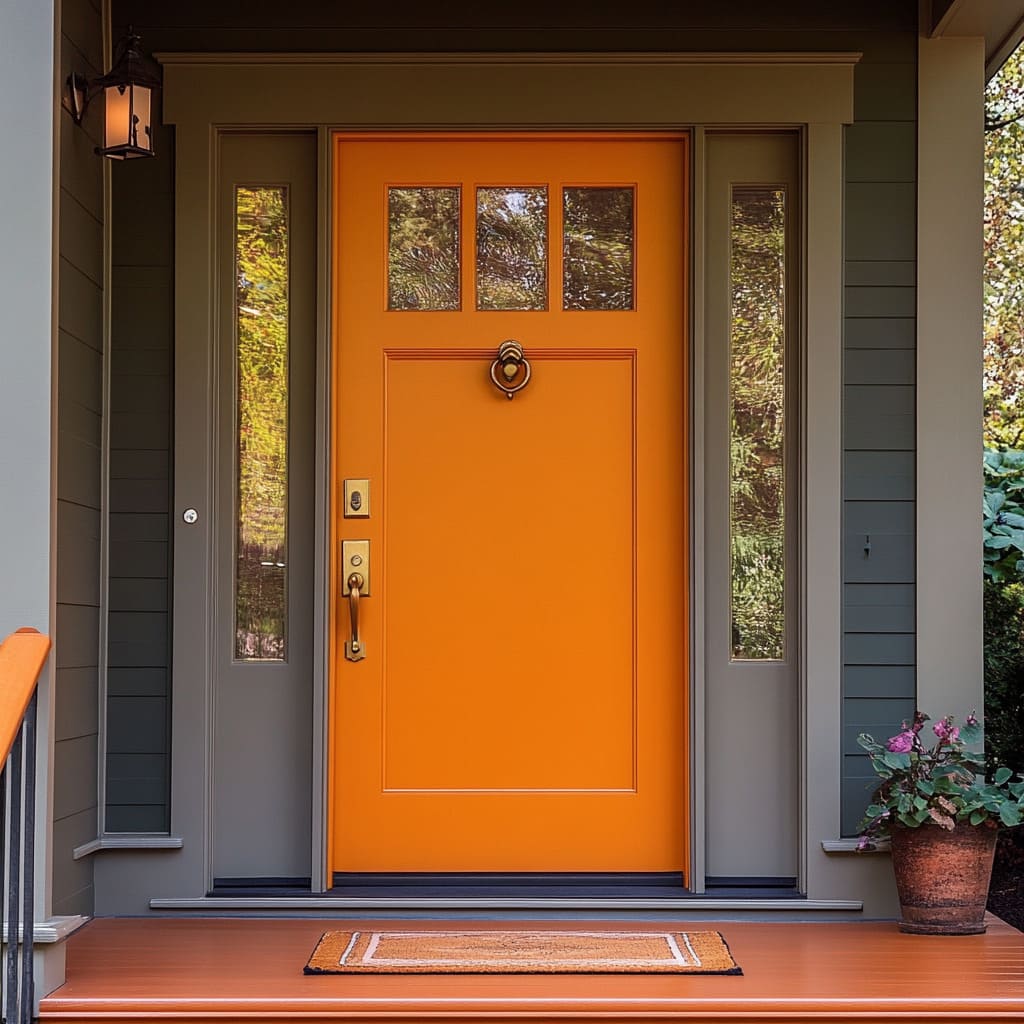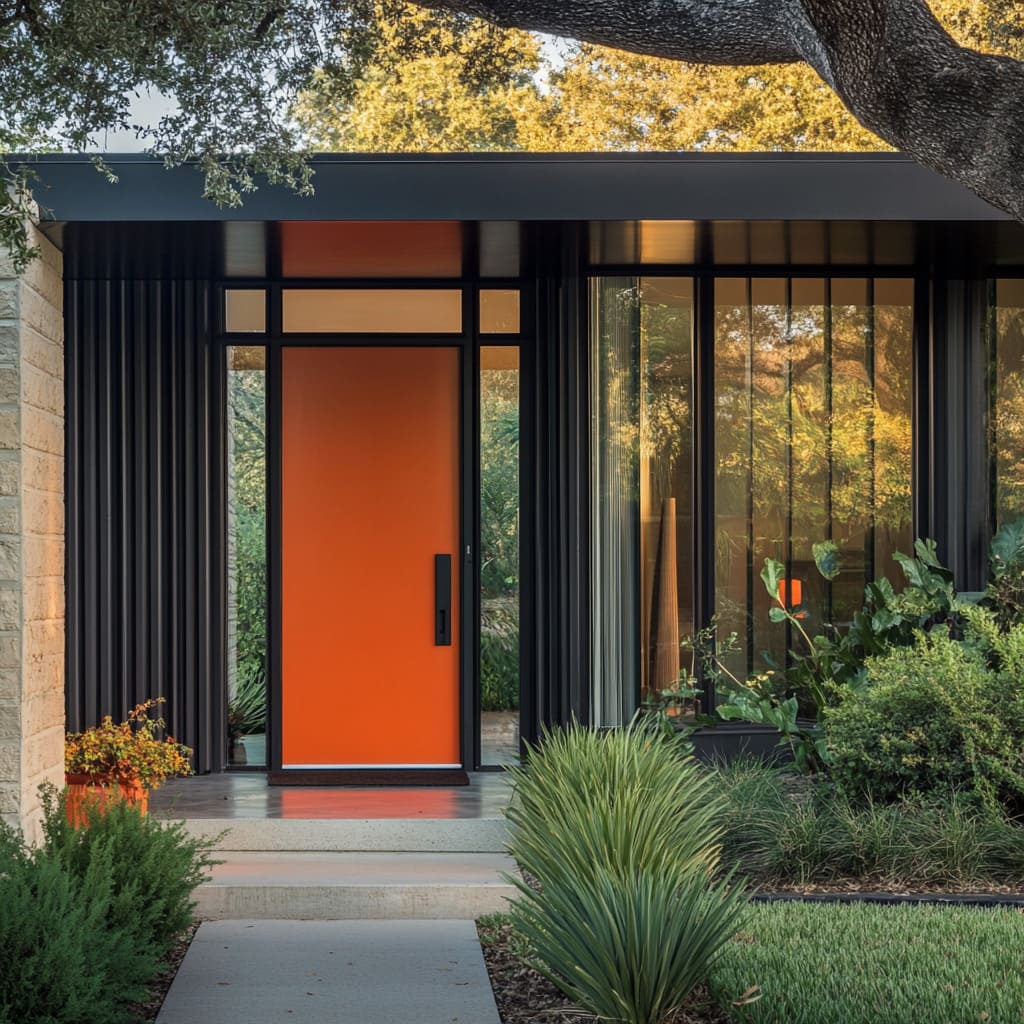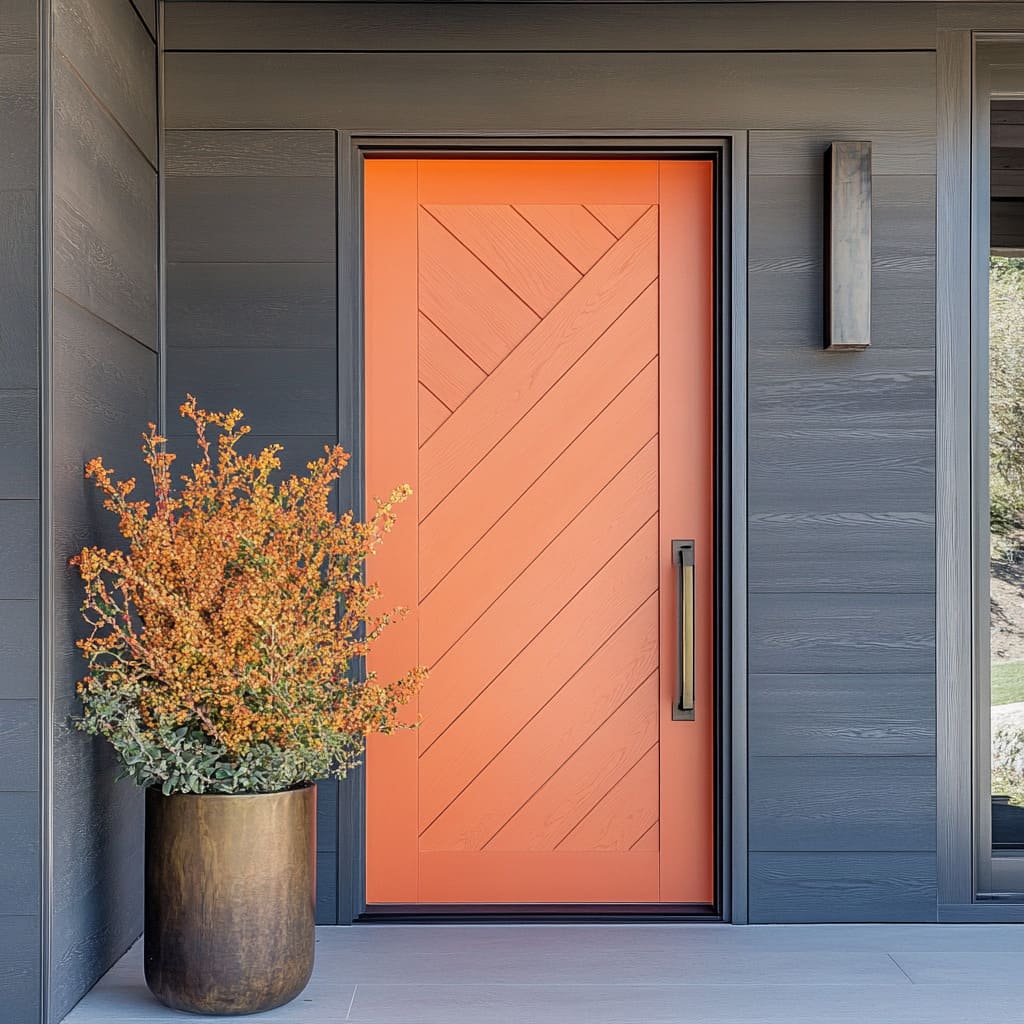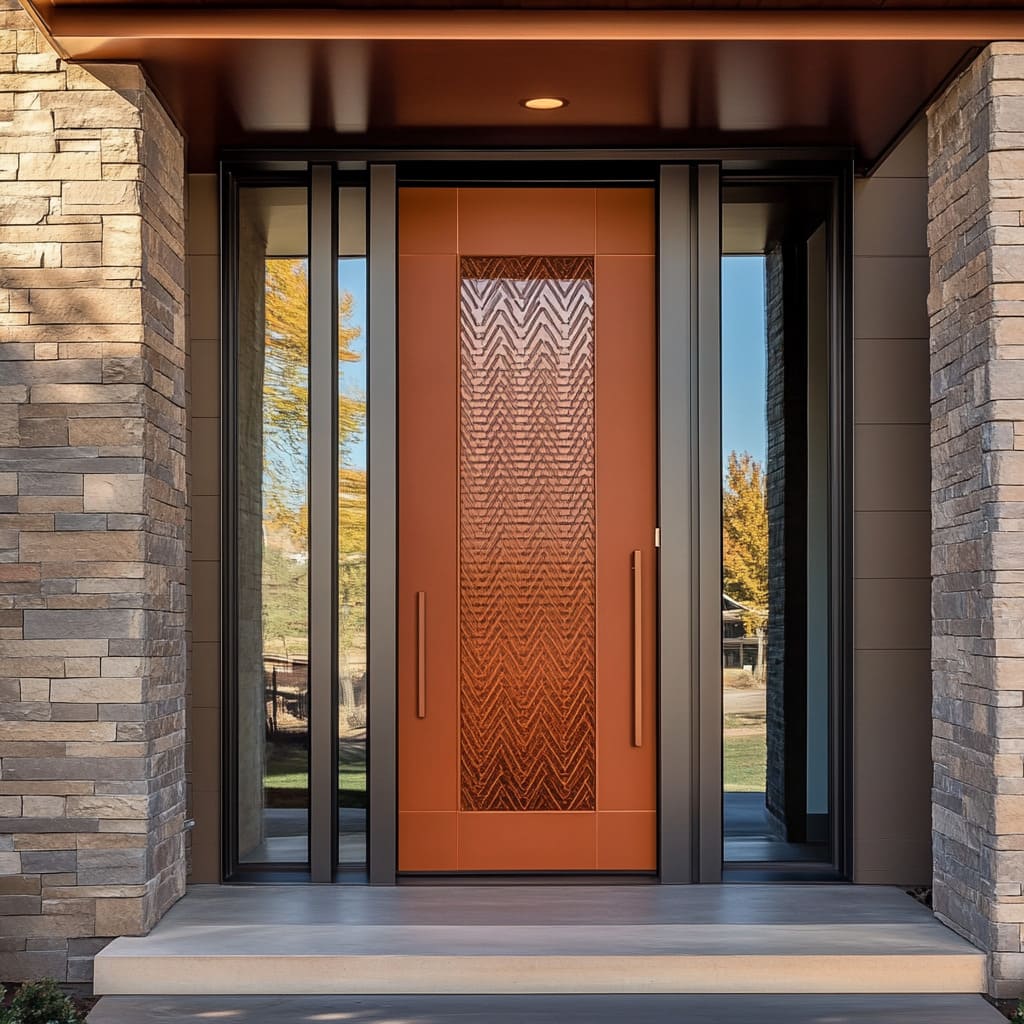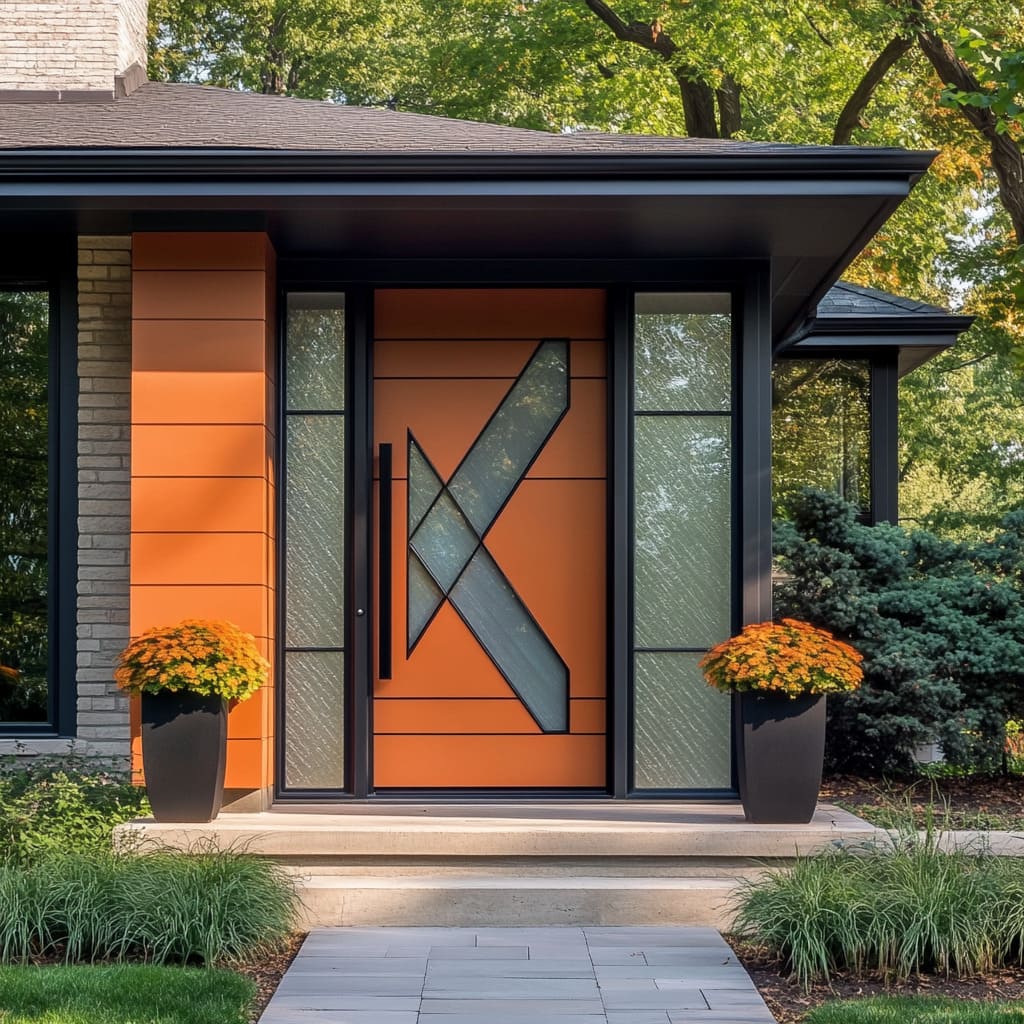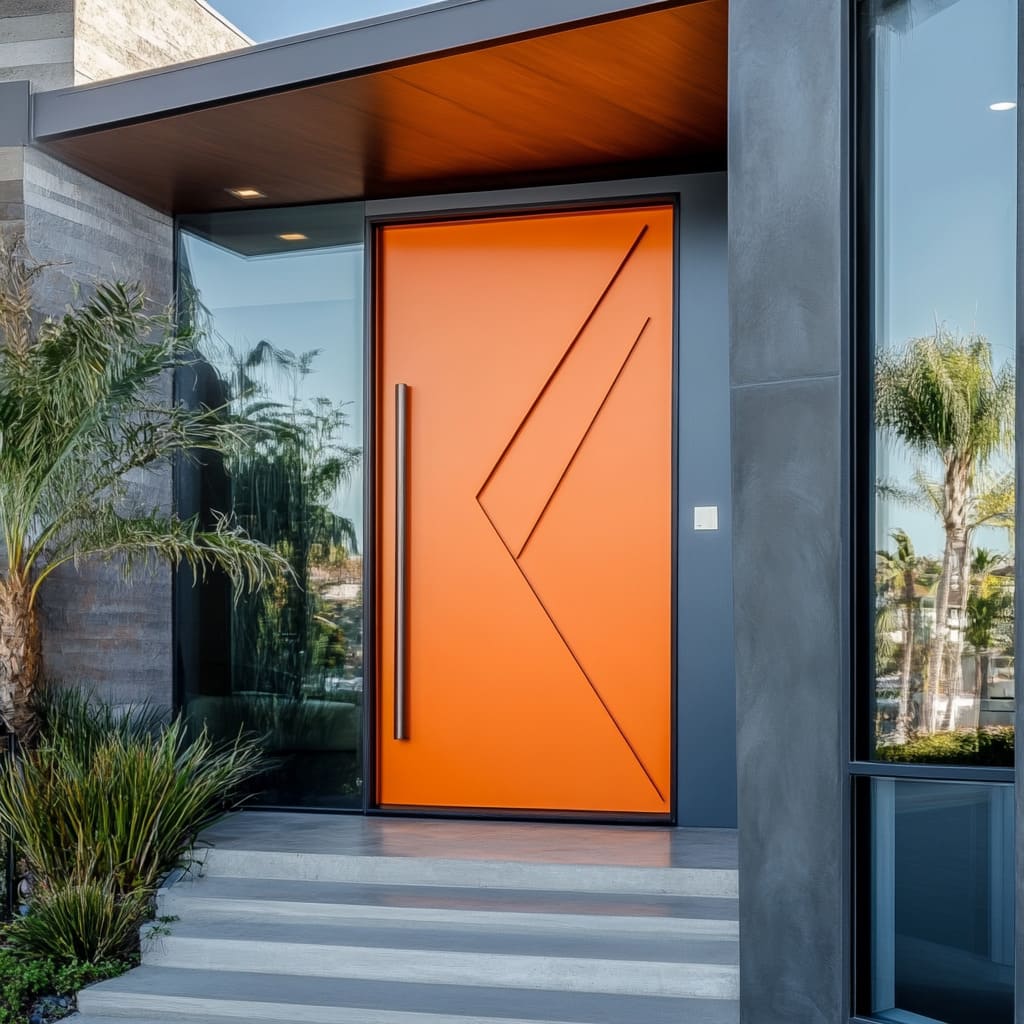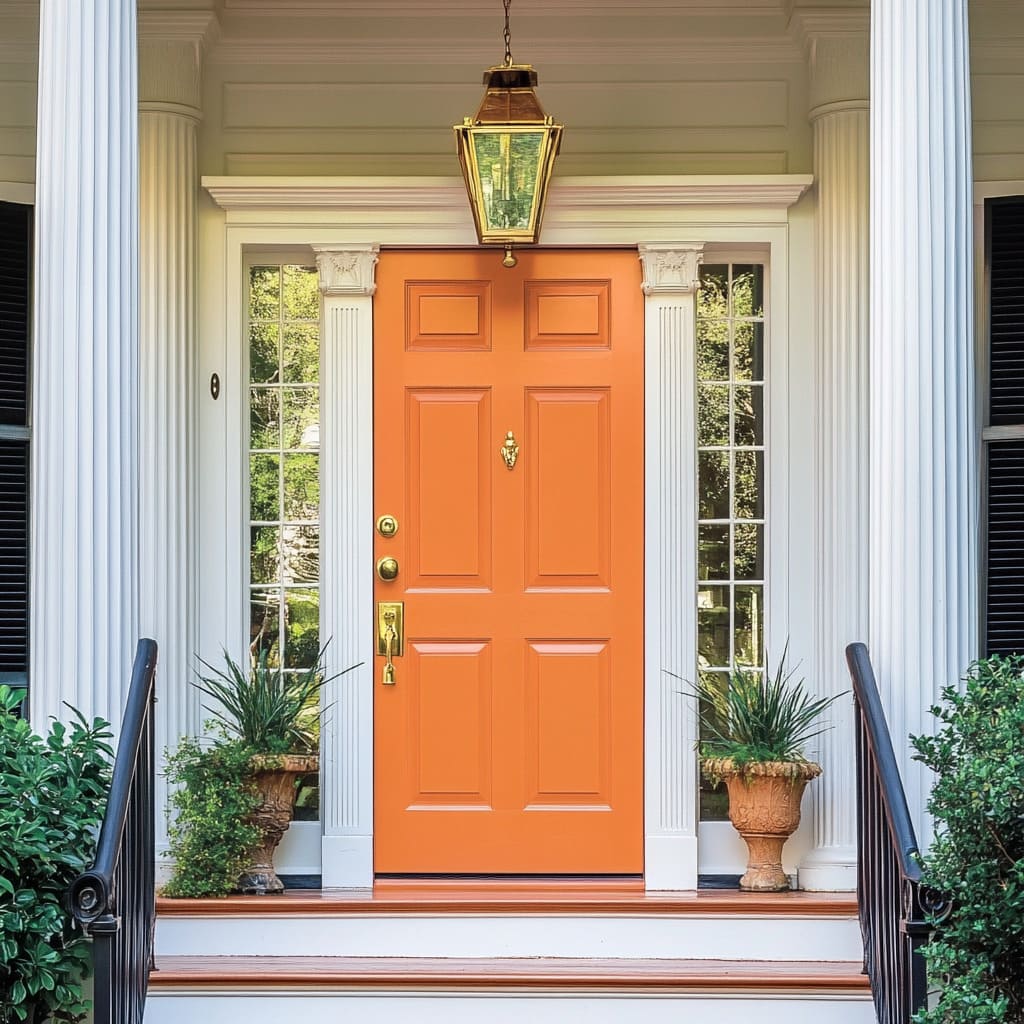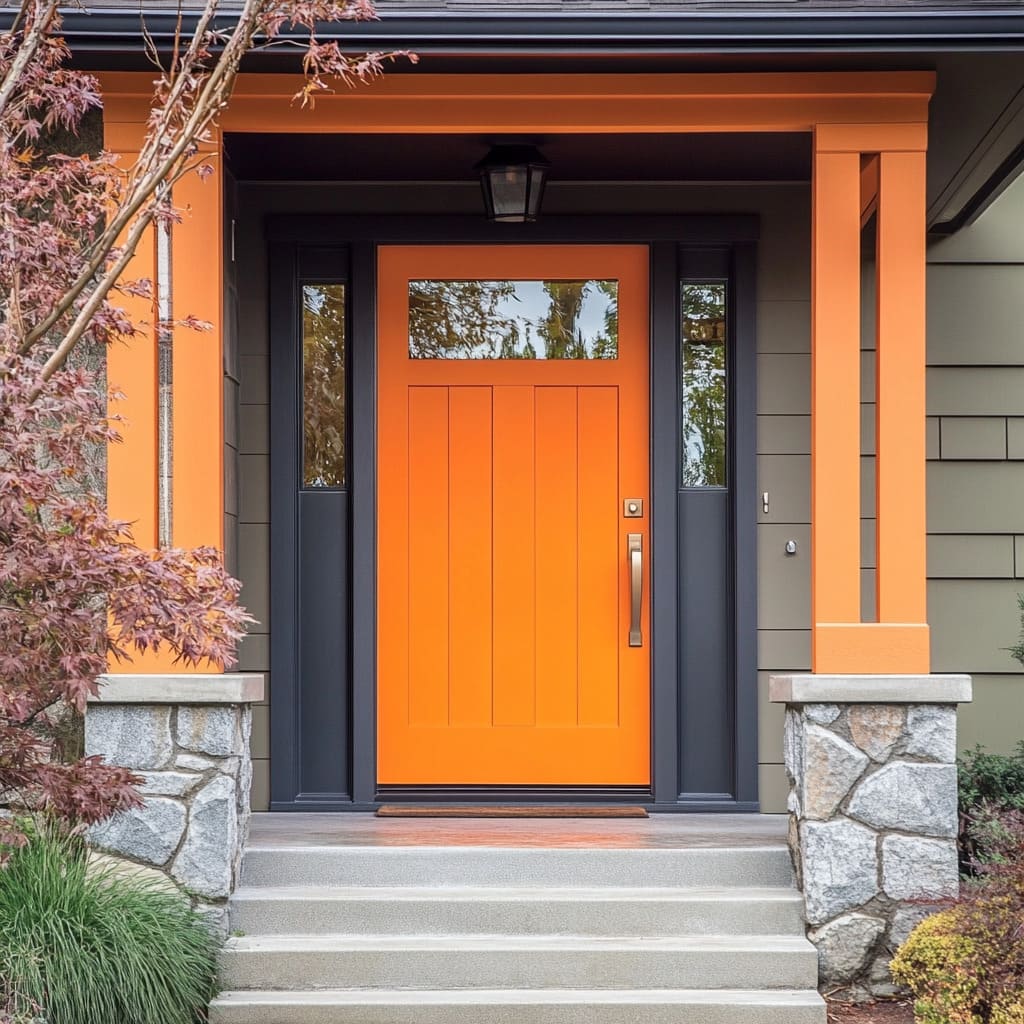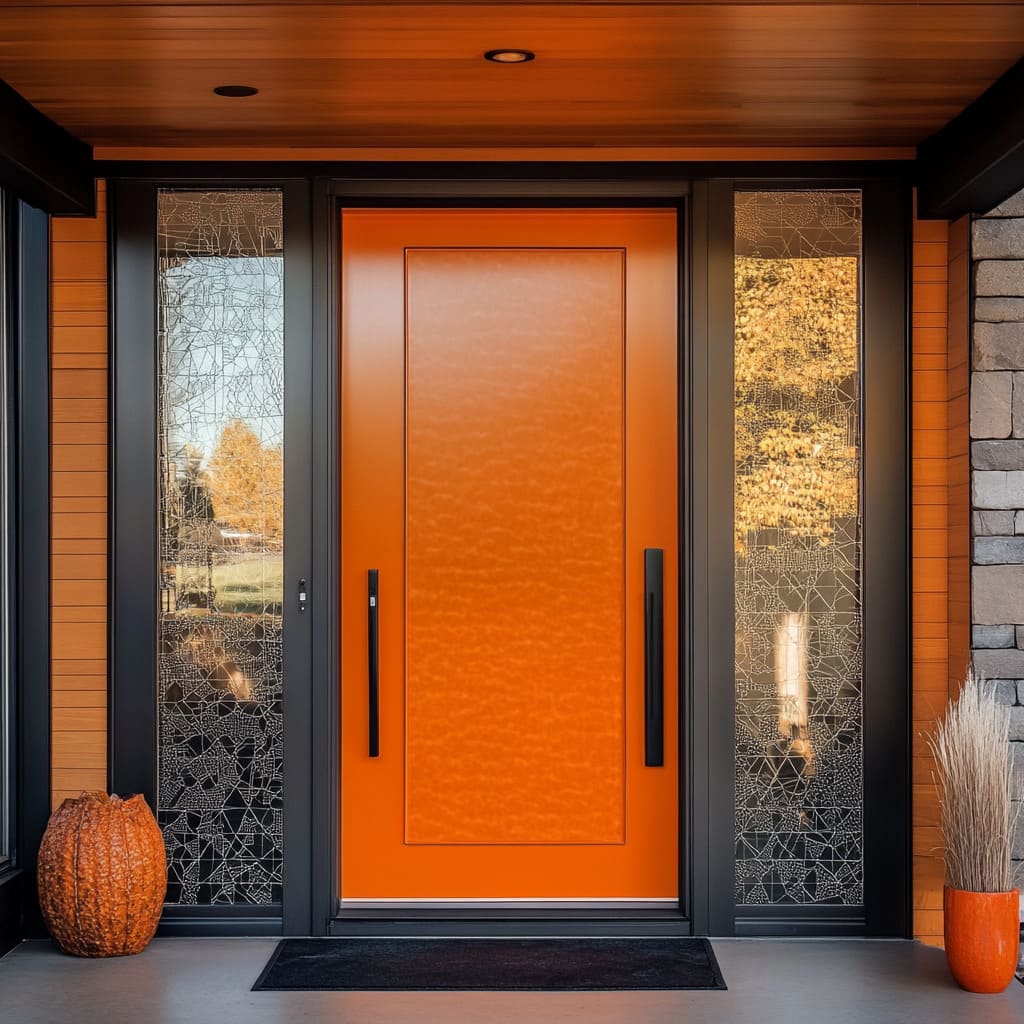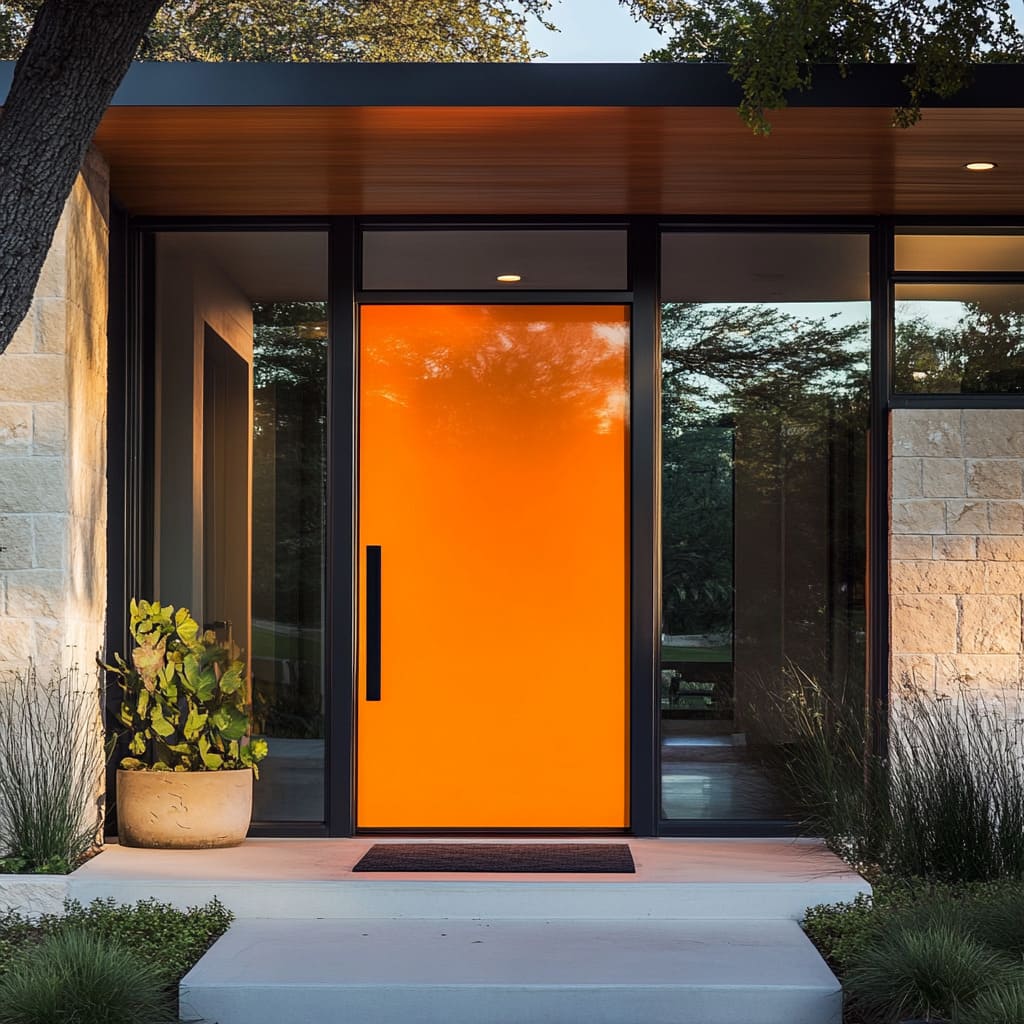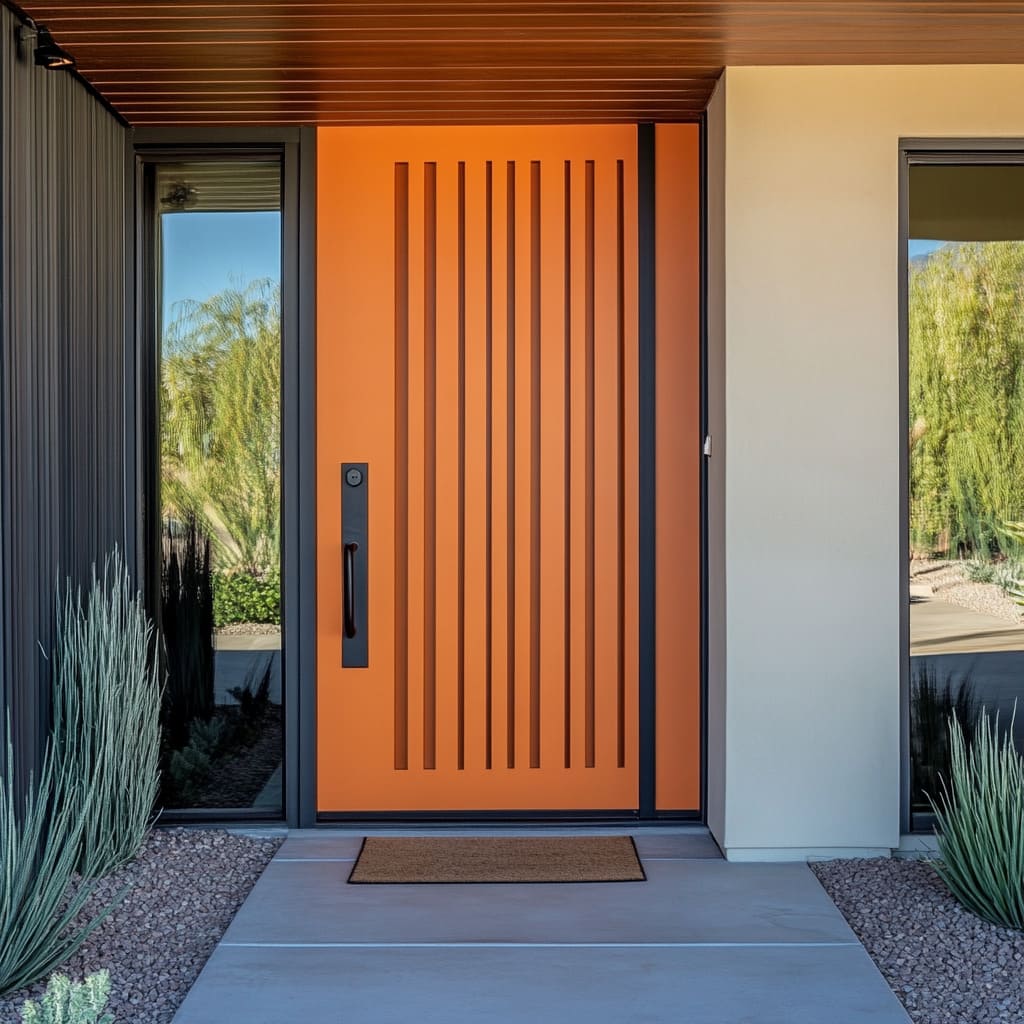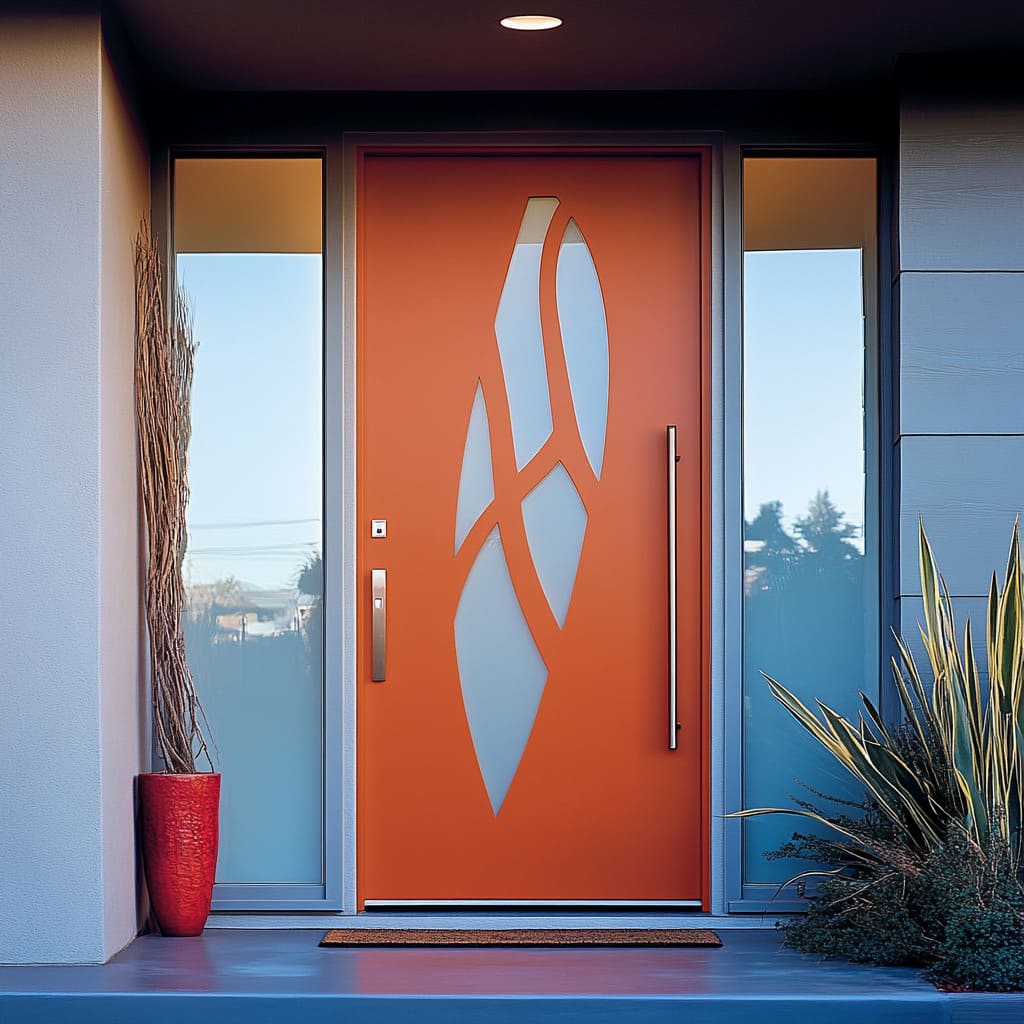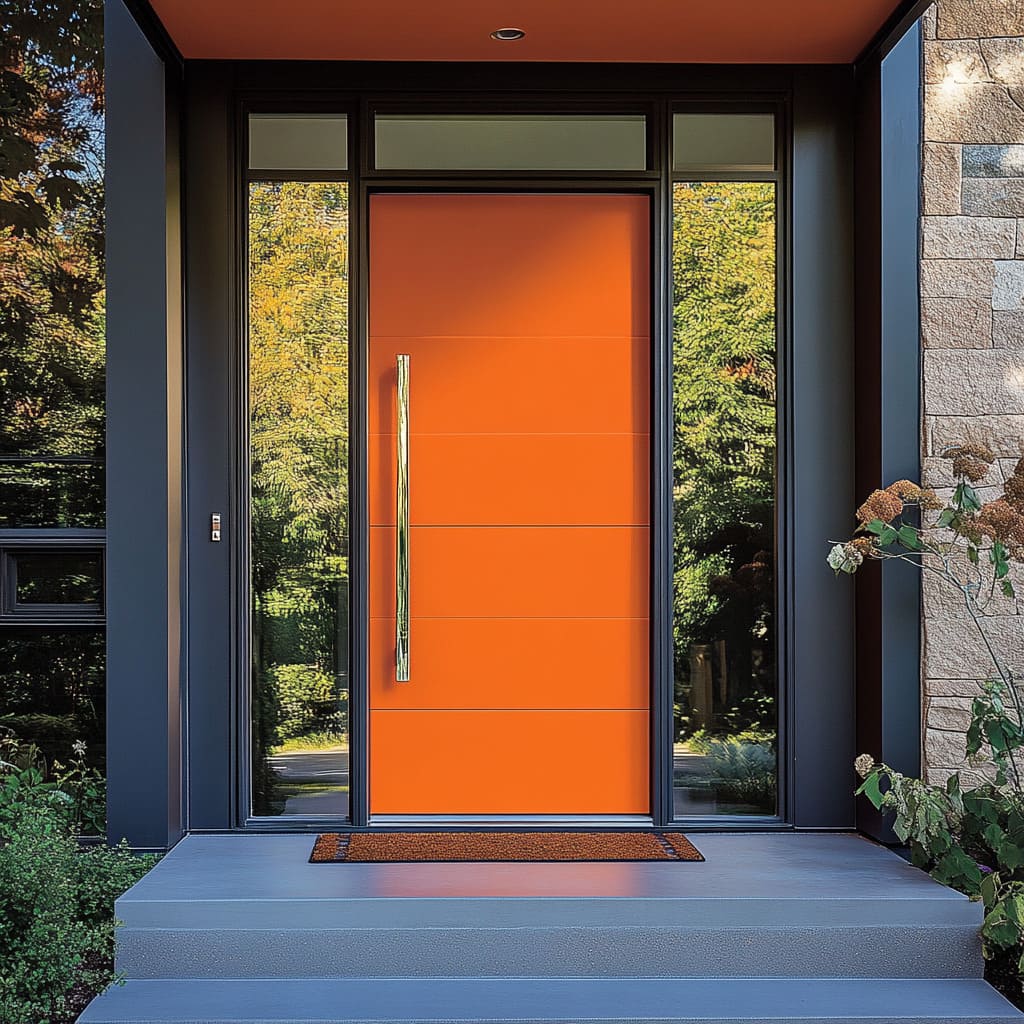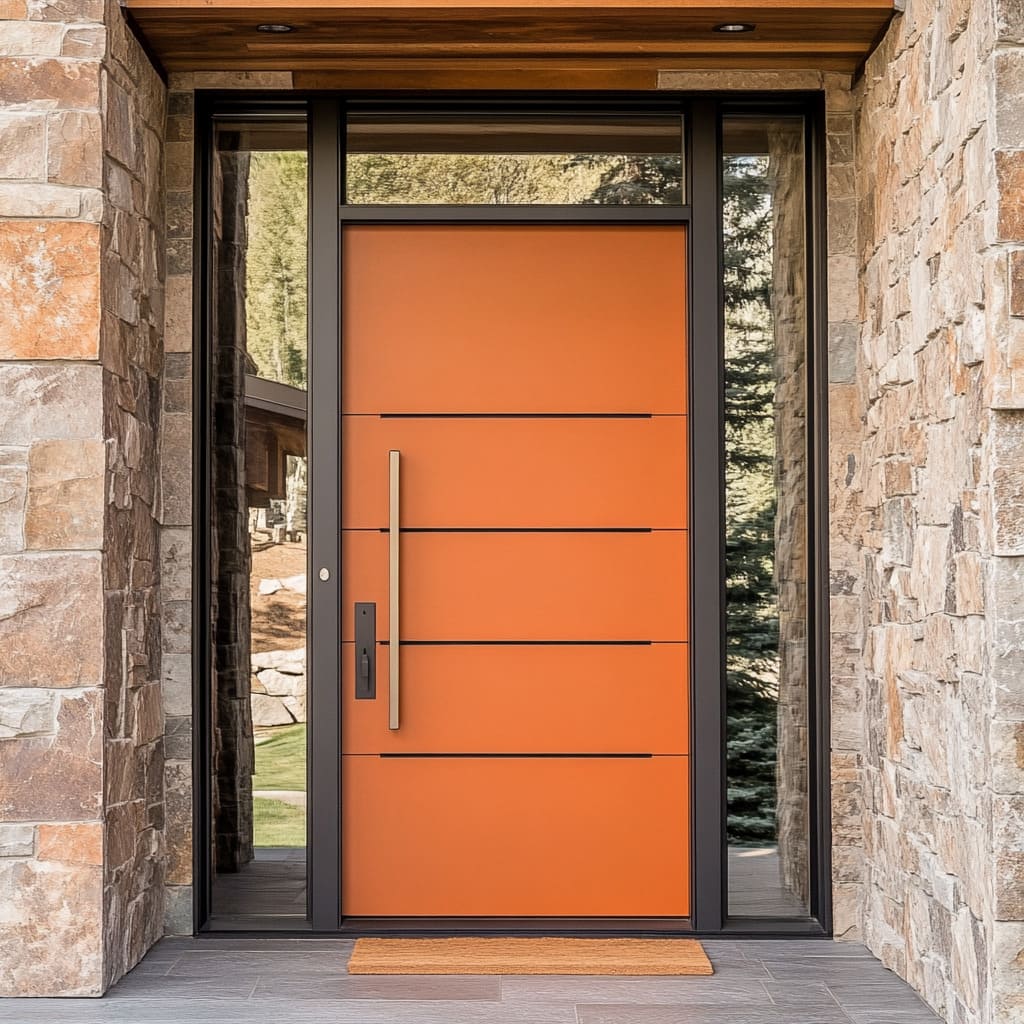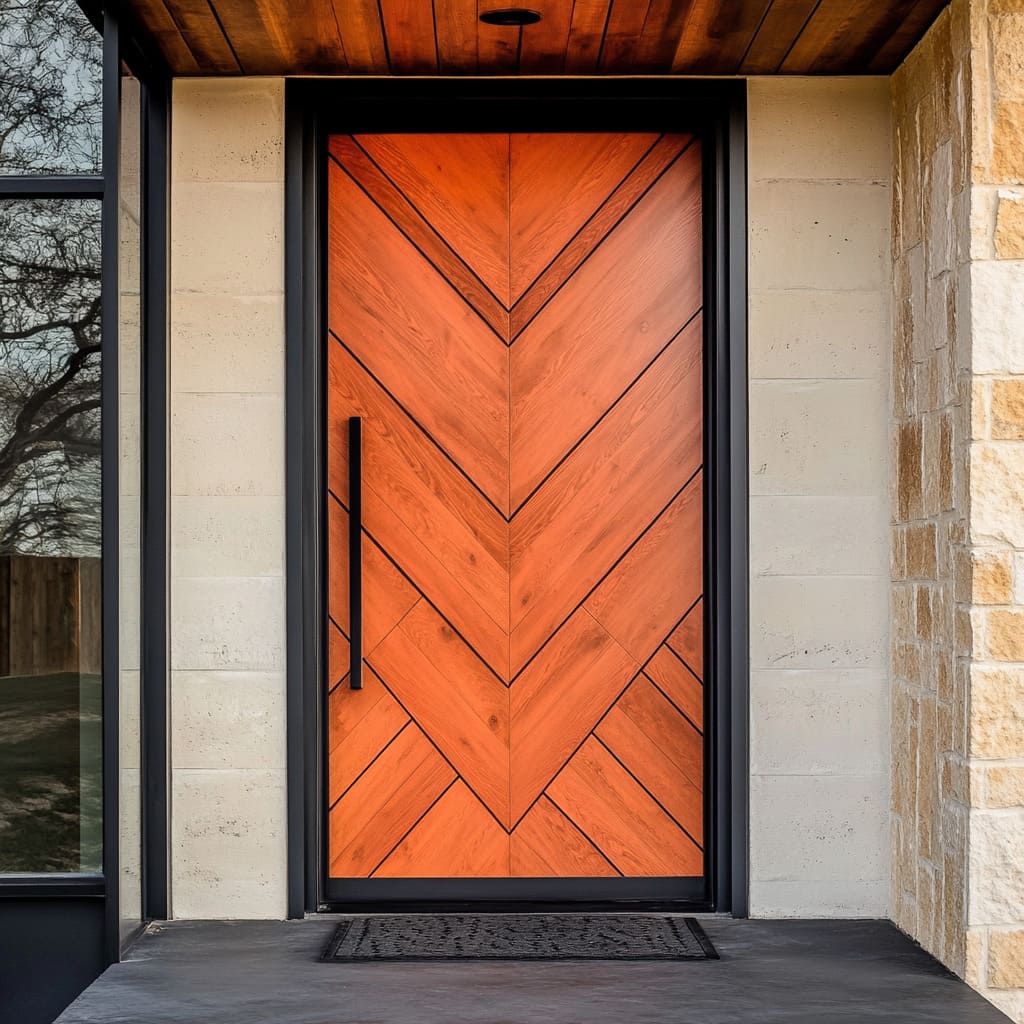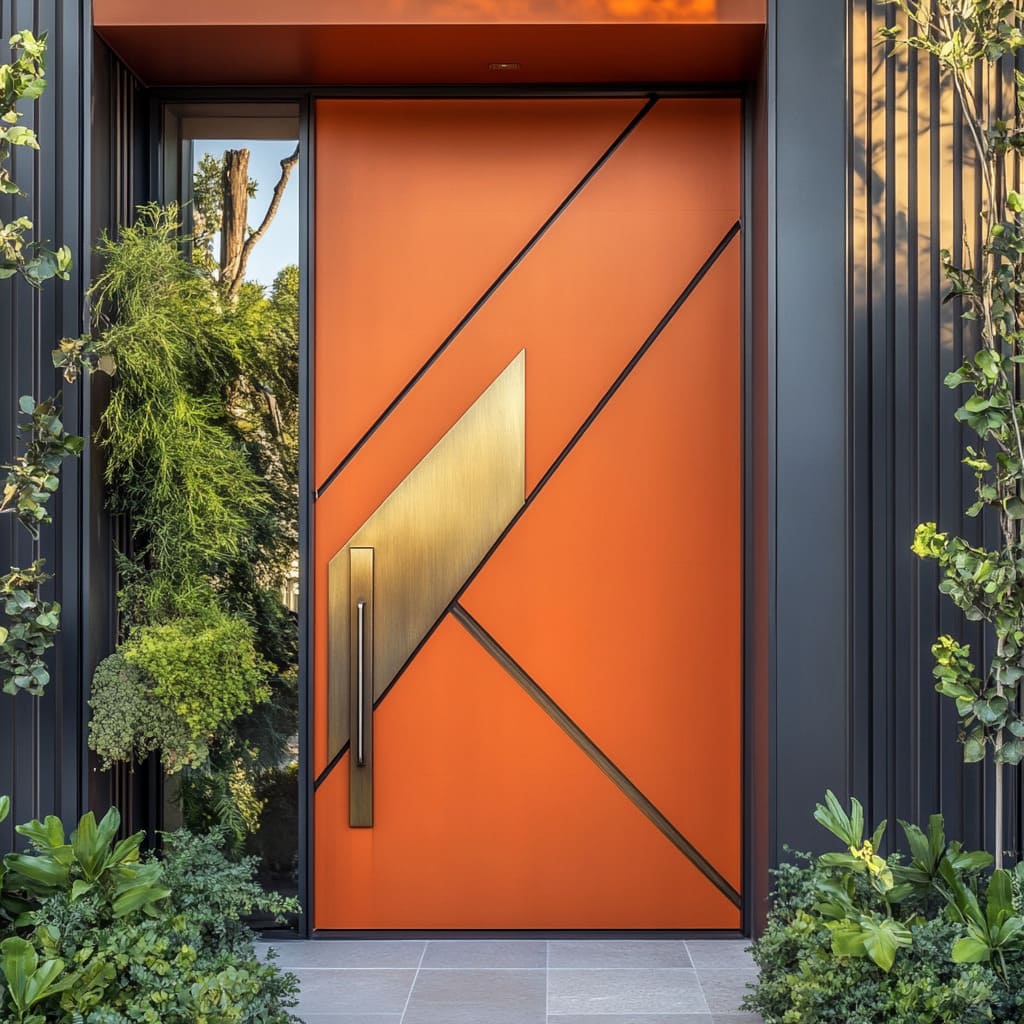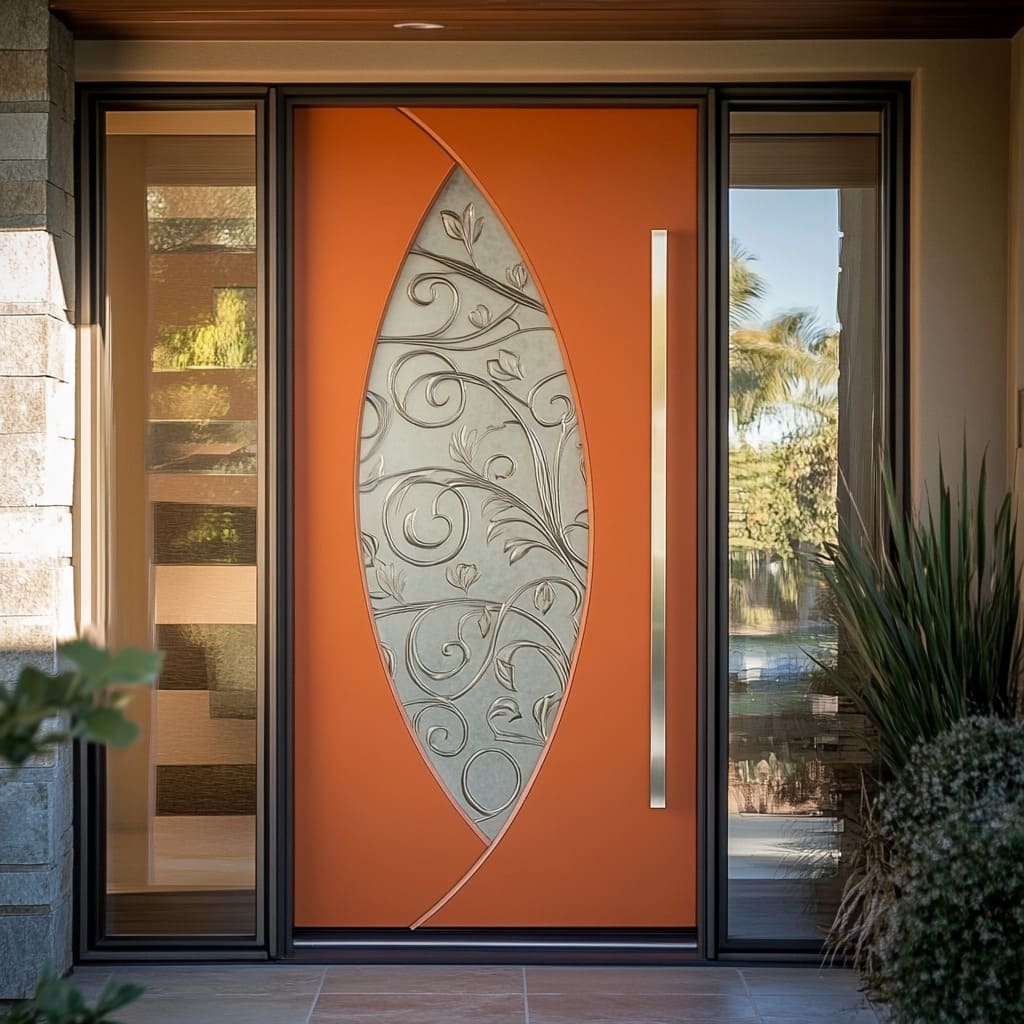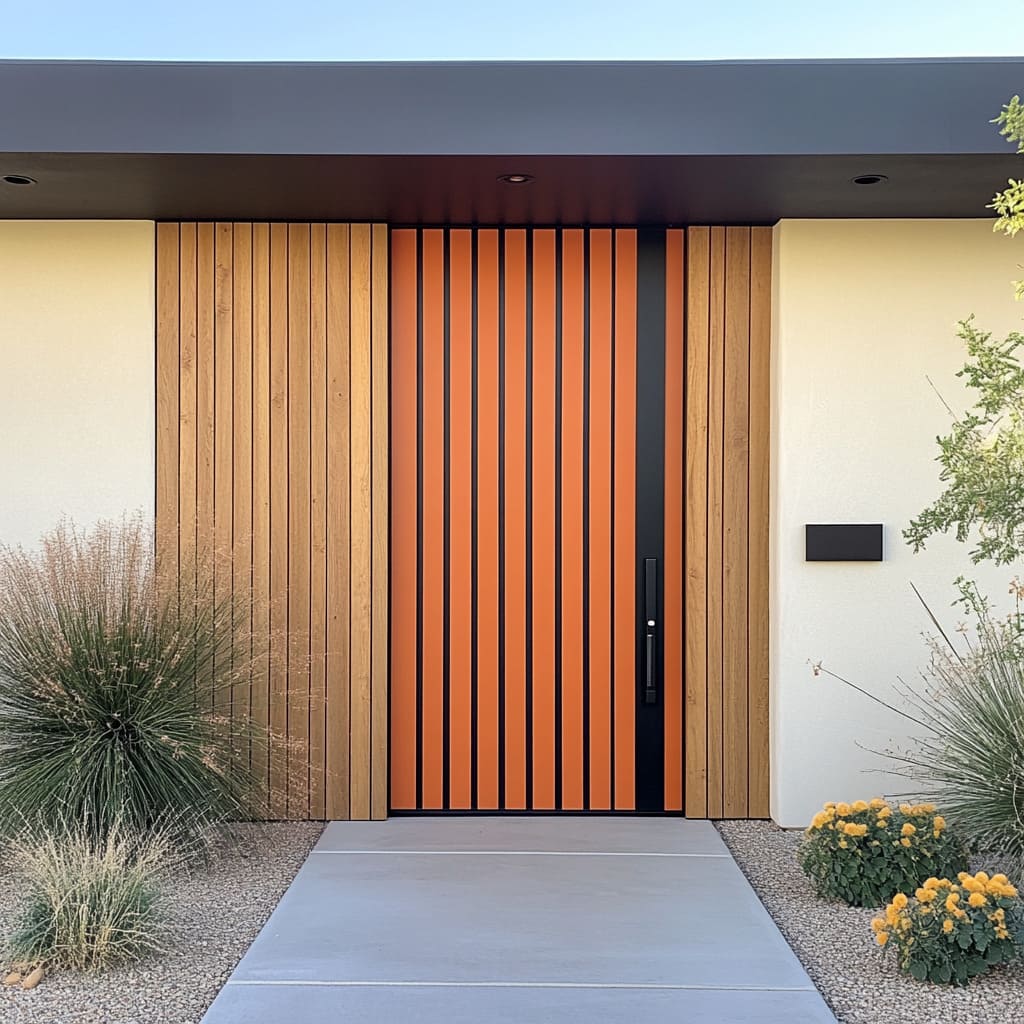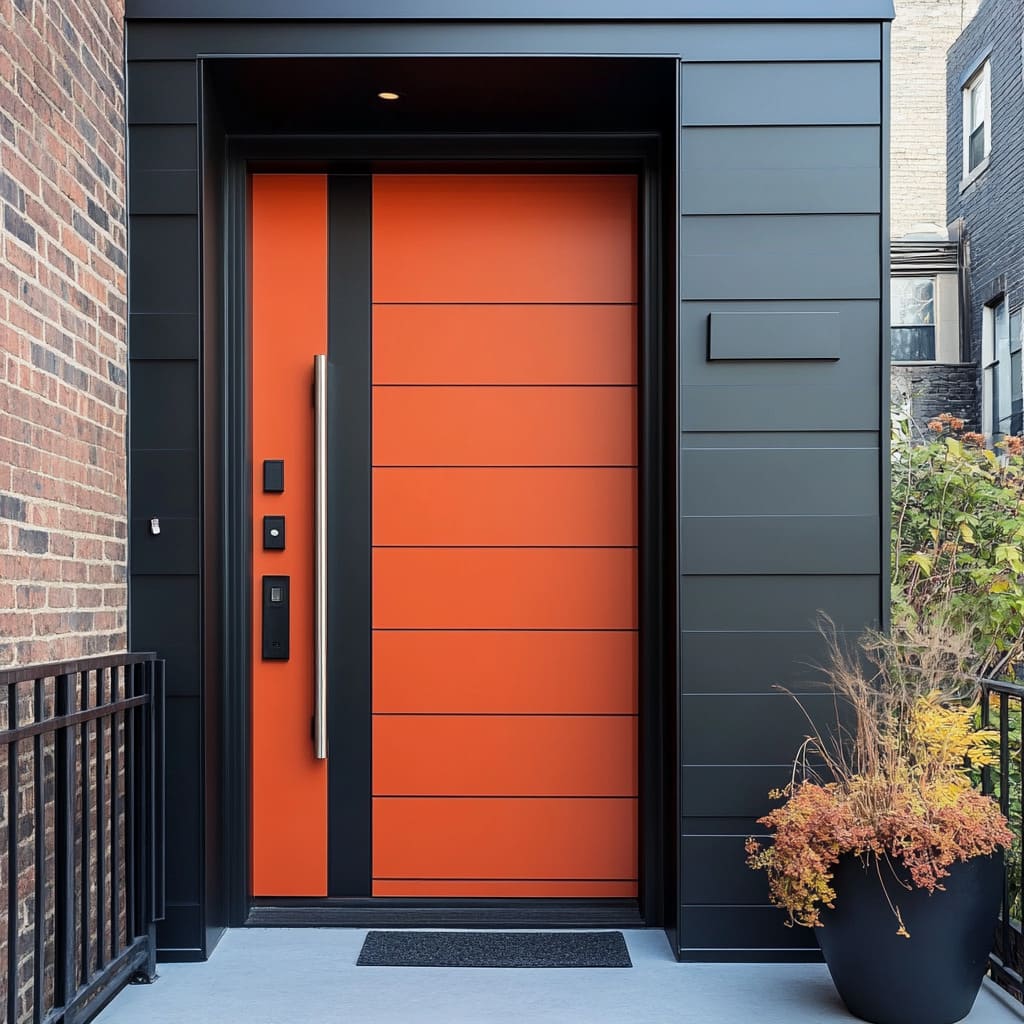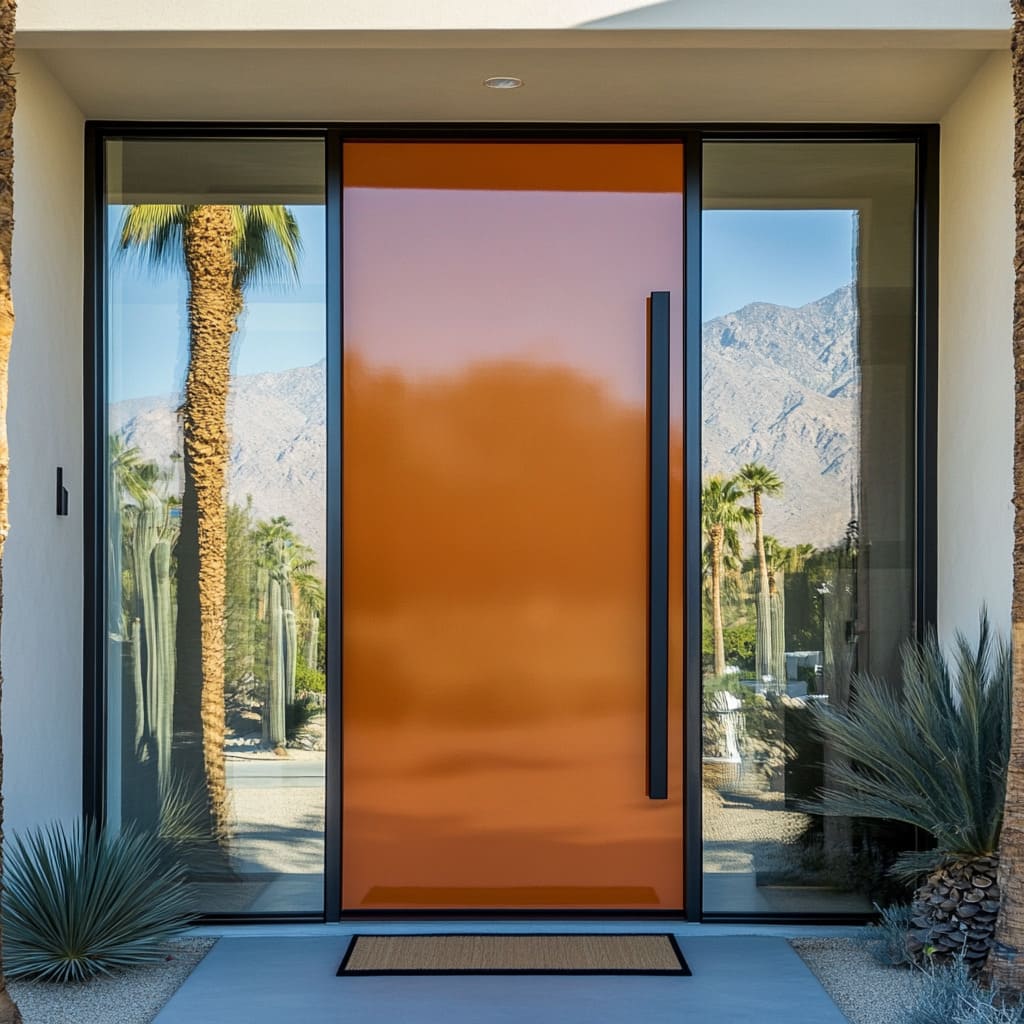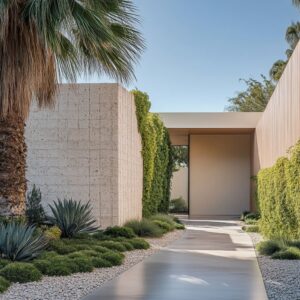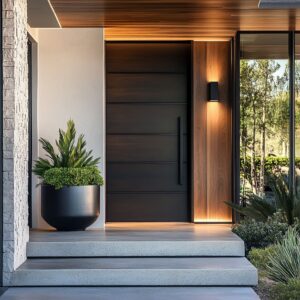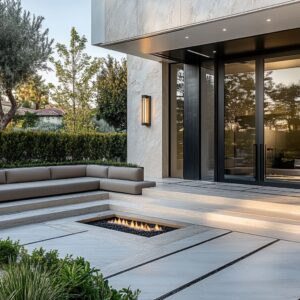A bold front door can completely transform the look and feel of your home, and few colors make a statement quite like burnt orange. This vibrant yet versatile hue bridges warmth and energy, offering a unique touch that suits a variety of architectural styles.
Whether you’re drawn to the sleek lines of modern design, the welcoming charm of a craftsman entry, or the rustic appeal of natural textures, a burnt orange front door can be the perfect way to add personality and character to your facade.
In this article, we’ll explore the many creative ways to incorporate this striking color, diving into the nuances of finishes, materials, and design details that make burnt orange such a standout choice. From the reflective sparkle of high-gloss surfaces to the timeless appeal of wood and stone pairings, there’s no shortage of inspiration to help you create a front entrance that leaves a lasting impression.
Let’s step into the world of design possibilities and find the right look to match your home’s character and surroundings.
Color Nuances and Surface Finishes
High-Gloss Sparkle
Burnt orange front doors with a high-gloss finish create an irresistible focal point, reflecting their surroundings with a dynamic, mirror-like quality. This style amplifies the natural light and nearby details, capturing everything from lush greenery to the clean lines of modern architecture.
A high-gloss sheen is especially striking in contemporary or mid-century homes, where the door becomes a bold statement, seamlessly blending with sharp geometric designs and minimalist landscapes. High-gloss finishes amplify both light and color intensity.
When positioned in areas that receive direct sunlight, the door’s surface can appear even more vivid, making the burnt orange tone feel larger than life. For homeowners who want a vibrant effect but with slightly less intensity, choosing a semi-gloss or satin finish can create a balance between impact and subtlety, softening the visual contrast against the rest of the facade.
Matte Subtlety
For a quieter yet equally captivating look, matte finishes on burnt orange front doors add a refined, understated charm. These muted surfaces bring depth to the color while blending effortlessly with a variety of materials.
One example highlights a matte finish paired with sleek metallic inlays, achieving a harmonious mix of modernity and warmth. This style works beautifully alongside rustic stone exteriors or homes with dark, minimalist facades, where the matte surface provides contrast without overwhelming the surrounding elements.
Matte finishes have the added advantage of masking minor imperfections, making them a practical choice for high-traffic entrances. Additionally, their subtle tone allows other design elements—like brushed metal fixtures or stone cladding—to stand out.
This combination of soft orange hues and textured details feels timeless while complementing both contemporary and traditional homes.
Coppery or Paprika Variations
Some burnt orange front doors lean toward copper-infused or paprika-inspired shades, offering a more grounded and earthy vibe. These slightly muted tones are ideal for homeowners who prefer a less vibrant and more natural look.
For example, coppery oranges seamlessly complement colonial-style homes with brass knockers or lanterns, while paprika hues bring warmth to craftsman-style exteriors with wooden columns or brick accents. These subtle variations in tone can bridge the gap between bold and neutral aesthetics.
They pair exceptionally well with natural materials like brick steps, aged wood, or stone walls, making them an excellent choice for homes that want to highlight historical or craftsman-inspired architecture. The interplay between these natural materials and the earthy orange shades creates a cohesive, welcoming entrance that feels both classic and fresh.
By thoughtfully choosing finishes and tonal variations, burnt orange front doors can transform an ordinary entryway into a unique expression of style, perfectly tailored to the character of any home. Whether aiming for high-gloss drama or a muted, organic feel, these doors offer endless ways to enhance your home’s curb appeal.
Geometric Patterns and Panel Arrangements
Horizontal Bands
Incorporating horizontal panels or inlays into a door design is a clever way to introduce a contemporary edge. Burnt orange front door ideas with horizontal metallic strips or grooves achieve a sleek, modern aesthetic while subtly enhancing the entrance’s visual width.
These horizontal elements create a sense of grounding and stability, making the entryway feel more substantial and architecturally integrated. This style is particularly effective for homes that already feature horizontal siding, as it creates a harmonious flow between the door and the broader facade.
Aligning horizontal bands with existing exterior lines, such as siding or window muntins, can result in a balanced and cohesive visual effect. On the other hand, intentionally contrasting horizontal bands with vertical siding introduces a layer of contrast that can energize minimalist or modern architectural designs.
For example, a smooth burnt orange finish paired with brushed metal strips creates a striking balance of warmth and industrial coolness.
Diagonals and Chevrons
Diagonal slats and chevron patterns are standout design elements that introduce dynamic movement to the door’s appearance. Unlike conventional vertical or horizontal panels, these angled layouts invite the eye to explore the door’s surface in a more engaging way.
The subtle shifts in light and shadow across these grooves or slats add depth and texture, making the burnt orange shade appear richer and more layered. This approach is particularly fitting for modern or transitional homes that aim to blend contemporary boldness with softer, approachable tones.
Doors with diagonal or chevron patterns are a practical choice for those wanting an intricate yet understated look. They deliver detail without overwhelming the overall design, which is perfect for homes that already feature strong architectural elements.
Angled grooves also emphasize craftsmanship and add a fresh take on modern entryway design, allowing the color to remain the star while the pattern provides additional intrigue.
Simple Single-Panel vs. Multi-Panel
A single-panel door design embodies simplicity and clean aesthetics, making it a popular choice for modern homes. The sleek surface, often enhanced with subtle grooves or a matte finish, allows the bold color to shine while maintaining a minimalistic charm.
On the other hand, multi-panel designs evoke traditional craftsmanship. Often seen with glass insets at the top or detailed trims, these layouts blend the warmth of burnt orange with timeless architectural roots, creating a welcoming and classic entrance.
If you prefer a modern vibe, a single-panel burnt orange door can emphasize clean lines while allowing hardware, such as a long vertical pull handle, to add contrast and visual interest. For homes with a more traditional or transitional style, multi-panel doors are an excellent way to combine historical influence with a fresh, bold color.
Glass insets, especially when frosted or textured, add elegance while letting in natural light, making the entryway more inviting. By exploring different geometric patterns and panel arrangements, burnt orange front doors can transform into tailored statements of personal style.
Whether opting for horizontal bands, bold diagonal lines, or traditional multi-panel layouts, the possibilities are vast and adaptable to various architectural themes. This versatility ensures that your door can seamlessly blend with or stand out against your home’s facade, delivering both form and function.
Metal Accents and Hardware
Brass vs. Silver vs. Black Accents
The choice of hardware and metallic details on a burnt orange door can redefine its personality, bridging the gap between subtle sophistication and bold expression. Brass accents, with their warm, golden tones, introduce a classic and refined vibe.
They shine particularly well alongside coppery orange tones or more traditional styles, blending a sense of timelessness with inviting warmth. Picture brass door handles or inlays glinting against the burnt orange hue, bringing a soft glow to your entryway.
Silver or stainless finishes present a modern, streamlined aesthetic. These cooler metallics create a sharp contrast that enhances clean lines, making them ideal for contemporary homes or mid-century inspired designs.
A stainless steel vertical handle or trim can lend the burnt orange color a precise, polished edge, adding to its versatility.
For those looking to create drama, black hardware provides a strong contrast that frames the door’s vibrant orange tones. Matte black handles or details act as a bold outline, drawing the eye toward the door as a focal point.
This pairing suits a variety of architectural styles, from sleek modern facades to transitional homes, where strong contrasts play a key role in the design narrative. When choosing hardware finishes, consider matching them to your home’s exterior elements for a unified look.
Brass might echo warm light sconces or house numbers, while black can coordinate with dark-framed windows or outdoor lighting fixtures. If your burnt orange door is exceptionally vivid, opting for darker hardware like black can balance the intensity, grounding the overall appearance.
Tall Vertical Handles vs. Smaller Knobs
The shape and placement of door hardware also hold the power to influence the overall design language of a burnt orange door. Tall vertical handles, often associated with modern or contemporary styles, add a sense of height and prominence to the door.
These elongated bars can align with existing grooves or metallic strips, emphasizing the door’s sleek, structured design. The verticality of these handles not only complements tall, narrow entryways but also enhances the symmetry of the facade.
In contrast, smaller knobs or knockers are more common in traditional or craftsman designs, offering charm and functionality. A central placement reinforces symmetry, giving the door a grounded and balanced look.
Knockers, especially those crafted from brass or aged metal, provide an additional layer of visual texture, serving both as a practical feature and an ornamental detail.
For those seeking a modern twist, consider experimenting with placement. An off-center vertical handle introduces a hint of asymmetry, adding an unexpected visual interest while maintaining a minimalist appeal.
Similarly, choosing handles or knobs in unique finishes, such as brushed silver or antique bronze, can create subtle contrasts against the burnt orange backdrop. Tall handles visually elongate the door, making them an excellent choice for single-slab or minimalist designs.
However, their placement matters—aligning them with architectural lines can create harmony, while a deliberate offset introduces a sense of movement. On the other hand, smaller knobs or knockers are perfect for those aiming for a more traditional feel, especially when paired with multi-panel doors or intricate glass insets.
Metal accents and hardware are the finishing touches that transform a burnt orange door into a complete, cohesive statement. Whether you lean toward warm brass, sleek silver, or bold black, these details allow your door to reflect both your personal style and the surrounding architectural character.
Balancing color, material, and shape ensures the door stands out while staying connected to its environment.
Glass Integration
Large Sidelights and Transparent Panels
Incorporating full-height glass sidelights alongside a burnt orange exterior door is an excellent way to flood the entryway with natural light while visually expanding the space. These sidelights not only make the door feel more prominent but also introduce a sense of openness to the entrance.
Modern homes often feature expansive glass panels for this reason, blending the indoors and outdoors seamlessly. For those who enjoy a connection to their surroundings, this setup can frame picturesque views while maintaining a bold, modern aesthetic.
However, privacy often becomes a concern with transparent glass. A clever alternative is frosted or textured glass, which diffuses light while obscuring the interior.
Some designs creatively use partial visibility, such as horizontal bands of transparency amidst frosted sections, to balance openness with discretion. This approach works particularly well for homes with close neighbors or busy streets, where privacy remains a priority without sacrificing the airy feel.
When planning for large sidelights, consider how the glass integrates with the door’s style. Frosted glass with geometric patterns can enhance a minimalist aesthetic, while textured glass adds depth and detail to transitional or traditional settings.
Matching the sidelight design with other architectural elements, like window grids or patio doors, can create a cohesive and intentional facade.
Small Insets or Traditional Windowpanes
For homes leaning toward a more classic or craftsman-inspired style, smaller glass insets or multi-paned sections offer a timeless charm. A burnt orange exterior door with glass panes positioned near the top brings in natural light while maintaining privacy for the lower half.
These smaller panes can be designed in various configurations—simple grids, arched tops, or even a row of rectangular windows—to align with the architectural tone of the house. Adding further detail, some designs incorporate decorative grillwork or intricate mullions over the glass.
These elements provide additional texture and visual interest, making the door feel like an integral part of the home’s heritage. Even a bold burnt orange color can feel grounded and cohesive when paired with traditional glass accents.
Smaller insets are a subtle yet impactful way to blend color with light. For historical or craftsman-inspired homes, these panes reinforce the architectural lineage while allowing you to experiment with modern finishes like frosted glass or intricate patterns.
This style also complements brick or stone facades, where detailed door designs bring balance to heavier materials.
Etched, Textured, or Patterned Glass
Etched or textured glass takes functionality to a new level by doubling as a decorative feature. Whether it’s abstract etching, geometric shapes, or floral-inspired designs, these glass treatments make the door’s glass inserts a focal point.
A burnt orange exterior door paired with textured glass can completely transform the look of the entry, creating an interplay of light and shadow that changes throughout the day. Patterns etched into glass, such as flowing lines or geometric grids, offer privacy without the need for curtains or blinds.
They also provide a level of artistry that can elevate an otherwise plain door. Doors with larger glass sections often integrate these designs to avoid feeling too exposed, striking the perfect balance between functionality and beauty.
Textured or patterned glass offers an opportunity to introduce subtle design elements that complement the door’s color and surroundings. For example, abstract patterns can echo the clean lines of modern architecture, while floral etching might soften the boldness of a burnt orange tone.
This combination not only draws attention but also adds sophistication to the overall design. Integrating glass into a burnt orange exterior door provides endless design possibilities, from modern sidelights to traditional panes or intricate etched designs.
Each choice offers a distinct way to enhance both functionality and aesthetics, ensuring your door stands out while harmonizing with the surrounding architecture. By carefully selecting the type and treatment of the glass, you can create an entryway that is as practical as it is visually striking.
Materials and Surrounding Textures
Stone, Brick, and Stucco
Burnt orange exterior door paint creates a striking contrast against natural, neutral-toned materials like stone, brick, and stucco. These combinations allow the door to stand out as a centerpiece while harmonizing with the broader palette of the home.
In homes with earthy brick or rugged stone facades, the burnt orange shade feels cohesive and grounded, adding a touch of warmth that complements the texture and tones of the materials. Meanwhile, when paired with smooth stucco in shades like crisp white or soft gray, the color becomes a bold modern statement, drawing attention with its vibrant energy.
Homeowners face the decision of whether to match or contrast the orange tone with the existing facade materials. A muted orange works beautifully with the varied textures of stone or brick, creating a subtle and seamless blend.
On the other hand, a brighter or more saturated shade pops against smooth stucco, offering a playful or avant-garde aesthetic. Both approaches can enhance the entryway, depending on whether you prefer a subdued or attention-grabbing style.
To create balance, consider the tones of your home’s exterior. For rustic or traditional materials like stone and brick, a softer burnt orange blends naturally and offers a cohesive charm.
For clean stucco facades or minimalist exteriors, a vivid orange can act as an accent, adding personality and character to the design.
Wood Elements
The addition of wood in soffits, porch ceilings, or supporting columns further elevates the interplay of textures. Wood brings warmth and natural tones that can either complement or contrast the brightness of a burnt orange exterior door.
Light-toned woods like cedar or teak amplify the brightness, giving the door a sunny, cheerful quality, while deeper tones like walnut or mahogany create a more balanced and grounded appearance. In homes where the porch structure or framing is largely wood, the burnt orange can be customized to harmonize with the natural grain.
A deeper orange echoes the rich tones of darker woods, creating an understated elegance. Alternatively, a more vivid hue of orange against wood highlights the contrast, giving the entrance a dynamic and contemporary edge.
Burnt orange doors framed by wooden elements work best when their tones are intentionally matched or contrasted. If the wood is light and warm, a slightly deeper orange provides balance.
If the wood is darker and more formal, a brighter orange offers a playful yet sophisticated counterpoint.
Landscaping Considerations
Landscaping often plays a significant role in emphasizing the visual impact of a burnt orange door. From desert-inspired cacti to lush greenery, plants and shrubs can frame the entryway and interact beautifully with the door’s vibrant hue.
Tall ornamental grasses or layered potted plants provide an organic, grounding element that complements the door’s bold color. In modern settings, clean-lined succulents like agave or yucca echo the geometric precision of contemporary architecture.
The finish of the door also interacts with the landscaping. A high-gloss finish might reflect nearby plants, integrating greenery into the door’s appearance and creating a dynamic play of light and movement.
On the other hand, a matte finish allows the door to stand as a more solid backdrop, letting the landscaping take center stage. Choose plants that complement the architectural style of your home and the finish of the door.
For structured or angular designs, spiky plants can mirror clean lines. For a more welcoming or traditional look, consider soft, trailing greenery or flowers in complementary colors like purples or deep greens to frame the space and create an inviting feel.
By thoughtfully coordinating materials, wood accents, and landscaping, you can elevate the impact of your burnt orange exterior door paint while creating a harmonious and visually engaging entryway. Whether your home leans rustic with earthy brick or sleek with smooth stucco, the surrounding elements play a crucial role in how the door color is perceived, ensuring the design feels intentional and balanced.
Choosing the Right Tone and Design for Your Home
Assess Your Architectural Style
The architectural style of your home provides a strong foundation for selecting the perfect burnt orange color front door. For modern or contemporary homes, sleek single-panel designs often feel like a natural match.
These doors thrive on simplicity, with smooth finishes or geometric detailing that echoes the clean lines of the structure. Metallic inlays, tall vertical handles, and finishes ranging from matte to high gloss amplify the modern aesthetic, making the entrance feel sharp and sophisticated.
For Craftsman or colonial homes, a more traditional approach often feels appropriate. Multi-panel doors or designs that incorporate classic knockers or smaller glass panes near the top evoke timeless appeal.
Subtle orange tones, leaning toward copper or earthy variations, complement the rich textures of brick and stone, blending seamlessly with the home’s character while adding a fresh pop of color. Let the existing style guide your door’s design.
Modern homes embrace bold simplicity, while colonial or Craftsman exteriors shine with more intricate paneling and subdued hues that integrate with their historical character.
Check Light Exposure
The direction of your entryway plays a critical role in how a burnt orange door will appear throughout the day. South-facing doors bathed in direct sunlight naturally intensify bright tones.
In these cases, a less saturated orange can maintain visual harmony without becoming overpowering, especially if paired with a satin or semi-gloss finish that softens the intensity. On the other hand, a north-facing or shaded entry may benefit from a bolder tone or even a high-gloss finish to make the door feel vibrant and welcoming despite the limited natural light.
The finish choice can dramatically alter the perception of the color—high gloss creates a polished, radiant look, while matte provides a softer, understated appeal. Consider how much sunlight your door will receive throughout the day.
Bright areas call for controlled tones and finishes, while shaded locations can handle bold colors and shinier surfaces that amplify visibility.
Coordinate with Trim and Hardware
The surrounding elements, such as trim and hardware, significantly affect the overall look of the door. Choosing a monochromatic approach, where the trim closely matches the burnt orange tone, creates a seamless and cohesive appearance.
Alternatively, contrasting trim in shades like black or dark gray can frame the door and make the color pop, adding depth and drama to the facade. The choice of hardware—whether brass, silver, or black—plays a subtle but impactful role.
Brass finishes radiate warmth and pair beautifully with coppery orange tones for a classic and welcoming vibe. Silver or stainless steel offers a sleek, modern touch that feels crisp and contemporary, while black provides a bold, anchoring element that enhances the door’s presence.
Pay attention to the relationship between the door, trim, and hardware. A monochromatic trim can create harmony, while contrasting edges and thoughtful hardware choices add sophistication and balance to the entryway.
Consider Glass Placement and Texture
Glass inserts are not just functional but also decorative elements that can shape the door’s personality. Large sidelights or full-height glass panels on either side of the door create an airy, open effect, often seen in modern homes.
If privacy is a concern, frosted or etched glass provides a balance, allowing light to filter through while obscuring direct views. Smaller glass insets or traditional grid-like windowpanes complement Craftsman or colonial homes.
These designs add charm and detail, while frosted or textured finishes ensure privacy without sacrificing light. Intricate patterns or etched designs can make the glass a focal point, especially on simpler door styles where the glass adds a touch of creativity and interest.
Choose glass inserts based on your design goals. Large panels enhance light and openness, while smaller panes or decorative textures add personality and privacy to your entryway.
Integrate the Landscaping
The landscaping surrounding your burnt orange front door plays a supporting role in how the entrance is perceived. Neutral or textural greenery—like ornamental grasses or shrubs—creates a harmonious backdrop that lets the door take center stage.
For a more integrated effect, consider plants with warm-toned leaves or flowers in complementary shades, like deep reds or marigold yellows, to tie the landscaping to the door. Desert-inspired landscaping, featuring succulents or agaves, complements modern or minimalist homes, emphasizing angular lines and a structured look.
For more traditional homes, softly trailing plants or clusters of colorful flowers create a cozy, inviting atmosphere that offsets the boldness of the door. Think about how your landscaping frames the door.
Neutral plants highlight the color, while warm-toned foliage creates an intentional blend that ties the entryway to the surrounding environment. By aligning the door’s tone, design, and surrounding elements with the architecture and landscaping, you can ensure your burnt orange color front door becomes a cohesive and captivating focal point.
This thoughtful coordination results in an entrance that is not only visually appealing but also reflective of your personal style and the home’s character.
Specific Aspects to Keep in Mind
Reflections in High-Gloss
A high-gloss finish doesn’t just amplify the shine of your door—it also interacts with its environment in intriguing ways. Reflective surfaces can capture nearby greenery, stone textures, or even the changing sky, creating a living, dynamic effect throughout the day.
For homes surrounded by lush landscaping or architectural details like brick columns, this play of reflections adds depth to the entrance. It’s not just about the door’s color; it’s how the color and finish interact with the surroundings, offering a subtle shift in tone as daylight changes.
This reflective quality can work beautifully for homes with minimalist exteriors, where the door’s surface becomes part of the landscape’s interplay. However, if the reflections feel too overpowering, a satin or semi-gloss finish may offer the same vibrancy with a softer visual impact.
Proportion and Trim Width
When choosing or designing a door, consider how its proportions interact with nearby architectural elements like siding, columns, or window frames. Horizontal or vertical lines on the door can either align with or intentionally contrast the existing lines of the facade.
For example, a door with horizontal inlays might mirror horizontal siding for a clean, cohesive appearance, or it can create contrast for a striking, modern effect. Trim width also plays a significant role.
Slim, dark trim around a burnt orange door creates a bold frame, making the color stand out even more. On the other hand, wider or lighter trim tones down the overall impact, blending the door into its surroundings.
A slight offset in alignment—like trim lines or panel grooves that don’t match the house’s lines exactly—can create visual interest. This approach is especially useful for contemporary homes, where asymmetry often feels more intentional and dynamic.
Seasonal Shifts
A burnt orange door has a unique ability to adapt to seasonal changes, offering a different mood throughout the year. In autumn, the door may harmonize with warm, earthy tones in the surrounding foliage, creating a cohesive, inviting look.
By contrast, during the starkness of winter, it becomes a bright focal point in a muted or snowy landscape, injecting life into an otherwise dormant setting. In spring and summer, the door’s vibrant tone might contrast beautifully with fresh greenery or blooming flowers.
This seasonal versatility makes burnt orange a truly flexible choice, allowing the door to complement or stand out depending on its environment. When selecting your shade of burnt orange, think about how it will interact with the changing colors of your landscaping throughout the year.
A slightly deeper tone might feel cozy in fall and winter, while still feeling rich and sophisticated in summer’s brighter light.
Hardware Placement
Small adjustments in hardware placement can have a surprisingly big impact on the overall design of your door. For instance, shifting a vertical handle slightly off-center introduces a contemporary flair, while a centered knocker or lever leans toward tradition.
Similarly, pairing the placement with the door’s panels or grooves—like aligning a handle with a metallic inlay—creates a sense of deliberate harmony. Consider the relationship between the hardware and the door’s surroundings.
Matte black handles, for example, can anchor a vibrant burnt orange tone, while brass or brushed silver adds a touch of refinement and works well with both modern and traditional designs. The choice and placement of hardware can subtly shift the door’s personality.
A vertical bar enhances height and sleekness, while central knobs or knockers feel more rooted in classic design.
Depth of Color Under Cloudy Light
One of the more intriguing aspects of a burnt orange door is how its tone evolves under different lighting conditions. On sunny days, a vibrant orange can feel bold and eye-catching, demanding attention.
However, under overcast skies, deeper shades of burnt orange often reveal a softer, more neutral side. This versatility allows the door to adapt to its environment, offering a mood that feels appropriate no matter the weather.
For homes in areas with frequent cloud cover, this muted quality can make a bold color feel less overwhelming. It also means your door will have a quiet charm even on dreary days, avoiding the overly bright look that some colors can take on under diffused light.
Deeper burnt orange tones are particularly suited to homes in regions with varied lighting conditions. They provide a more consistent and balanced appearance, adapting seamlessly to both bright and subdued days.
By keeping these specific details in mind—like reflective finishes, proportional trim, seasonal interactions, and the adaptability of burnt orange tones—you can make thoughtful choices that elevate your door’s impact. Each element contributes to creating an entryway that feels intentional, balanced, and beautifully tailored to your home’s personality.
Conclusion
A burnt orange front door has tremendous versatility—it can be vibrant and ultra-modern, or it can feel warm and time-honored. By carefully selecting finishes (matte, satin, high-gloss), hardware (brass, black, silver), and panel or inlay patterns (horizontal, diagonal, chevron, etc.
), you can craft an entrance that integrates seamlessly with your home’s overall style. Equally important is paying attention to the facade’s materials—stone, stucco, siding, wood—and the surrounding landscaping, ensuring the door neither clashes nor fades away.
In the end, the “perfect” burnt orange door is one that balances brightness with the architectural form, respects privacy and transparency needs, and includes harmonious finishing touches—from well-chosen planters to thoughtfully placed handles. By applying the nuanced considerations above, you can confidently select a shade and design that spotlight your home’s entrance in the best possible way.

